Business Decision Making: Analyzing the Impact of Technology on Shopping Habits
VerifiedAdded on 2024/05/30
|25
|3658
|402
AI Summary
This assignment explores the impact of technological advancements and multi-channel shopping on traditional retail outlets, specifically high street shops and shopping malls. The study utilizes both primary and secondary research methods, including a questionnaire survey conducted among students on four university campuses. The survey aims to understand the changing shopping preferences of students and the factors influencing their choices. The assignment also delves into capital budgeting techniques, analyzing the payback period, IRR, and NPV through a practical example. The research concludes by examining the future of traditional retail in the face of evolving consumer behavior and technological innovation.
Contribute Materials
Your contribution can guide someone’s learning journey. Share your
documents today.
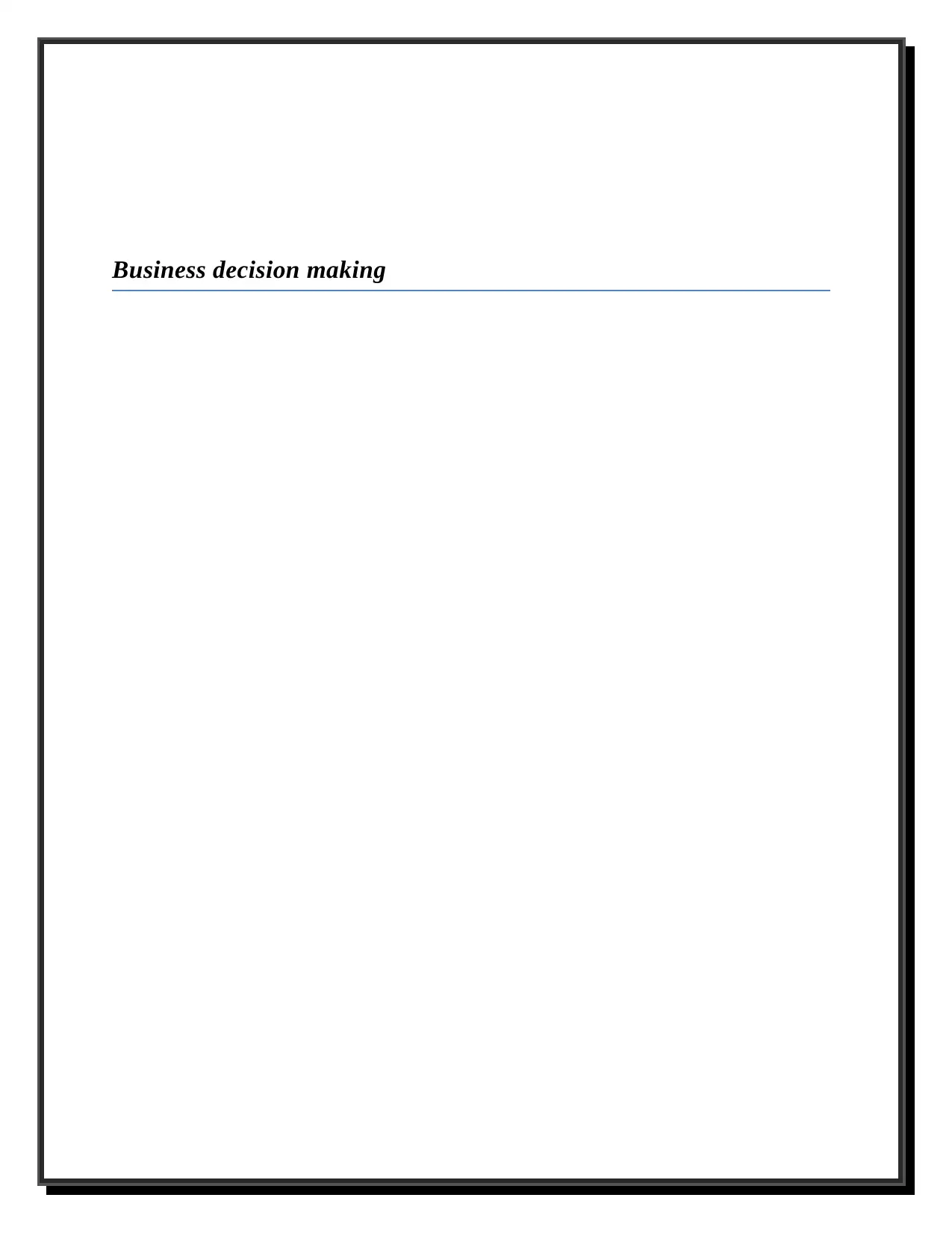
Business decision making
Secure Best Marks with AI Grader
Need help grading? Try our AI Grader for instant feedback on your assignments.
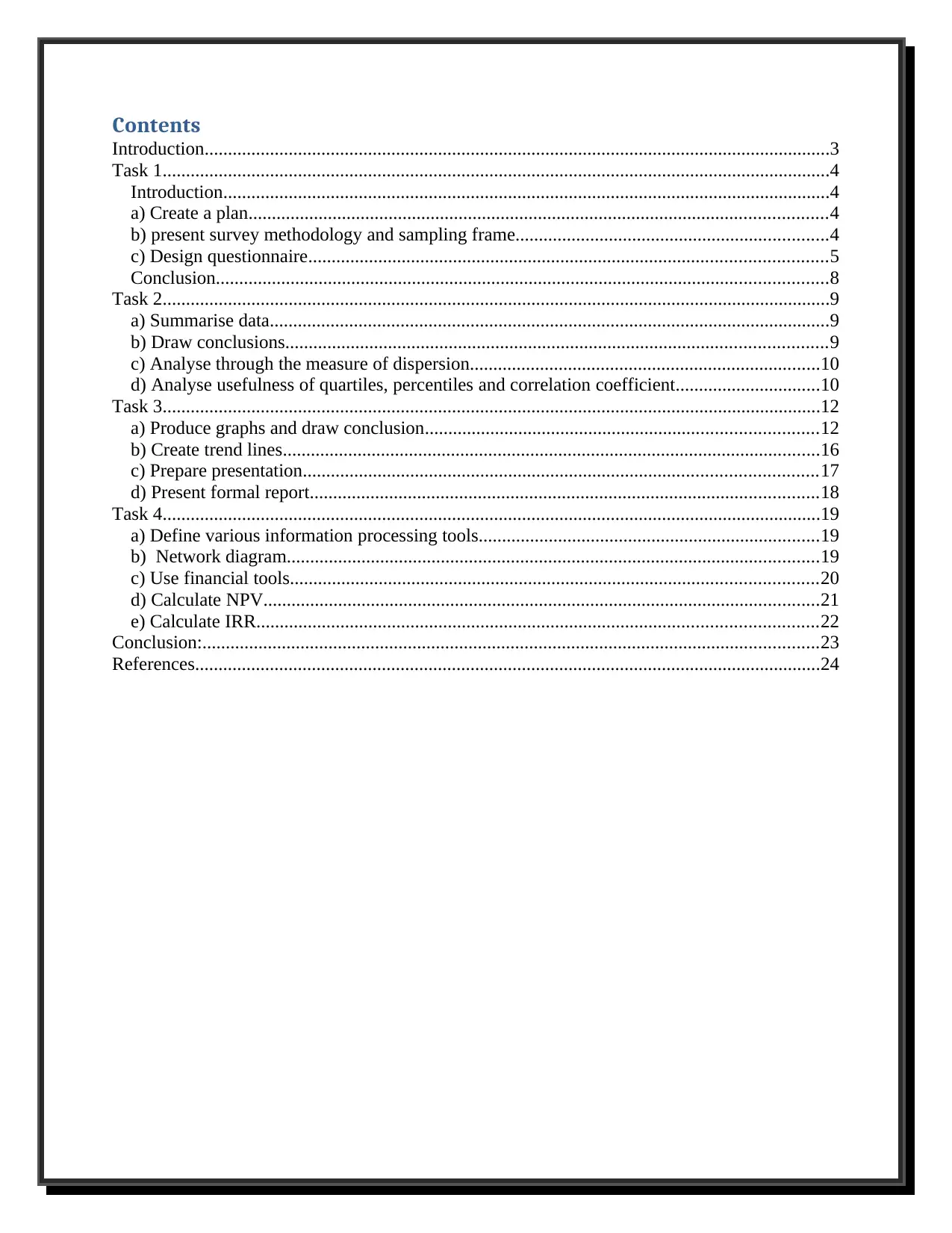
Contents
Introduction......................................................................................................................................3
Task 1...............................................................................................................................................4
Introduction..................................................................................................................................4
a) Create a plan............................................................................................................................4
b) present survey methodology and sampling frame...................................................................4
c) Design questionnaire...............................................................................................................5
Conclusion...................................................................................................................................8
Task 2...............................................................................................................................................9
a) Summarise data........................................................................................................................9
b) Draw conclusions....................................................................................................................9
c) Analyse through the measure of dispersion...........................................................................10
d) Analyse usefulness of quartiles, percentiles and correlation coefficient...............................10
Task 3.............................................................................................................................................12
a) Produce graphs and draw conclusion....................................................................................12
b) Create trend lines...................................................................................................................16
c) Prepare presentation..............................................................................................................17
d) Present formal report.............................................................................................................18
Task 4.............................................................................................................................................19
a) Define various information processing tools.........................................................................19
b) Network diagram..................................................................................................................19
c) Use financial tools.................................................................................................................20
d) Calculate NPV.......................................................................................................................21
e) Calculate IRR........................................................................................................................22
Conclusion:....................................................................................................................................23
References......................................................................................................................................24
Introduction......................................................................................................................................3
Task 1...............................................................................................................................................4
Introduction..................................................................................................................................4
a) Create a plan............................................................................................................................4
b) present survey methodology and sampling frame...................................................................4
c) Design questionnaire...............................................................................................................5
Conclusion...................................................................................................................................8
Task 2...............................................................................................................................................9
a) Summarise data........................................................................................................................9
b) Draw conclusions....................................................................................................................9
c) Analyse through the measure of dispersion...........................................................................10
d) Analyse usefulness of quartiles, percentiles and correlation coefficient...............................10
Task 3.............................................................................................................................................12
a) Produce graphs and draw conclusion....................................................................................12
b) Create trend lines...................................................................................................................16
c) Prepare presentation..............................................................................................................17
d) Present formal report.............................................................................................................18
Task 4.............................................................................................................................................19
a) Define various information processing tools.........................................................................19
b) Network diagram..................................................................................................................19
c) Use financial tools.................................................................................................................20
d) Calculate NPV.......................................................................................................................21
e) Calculate IRR........................................................................................................................22
Conclusion:....................................................................................................................................23
References......................................................................................................................................24
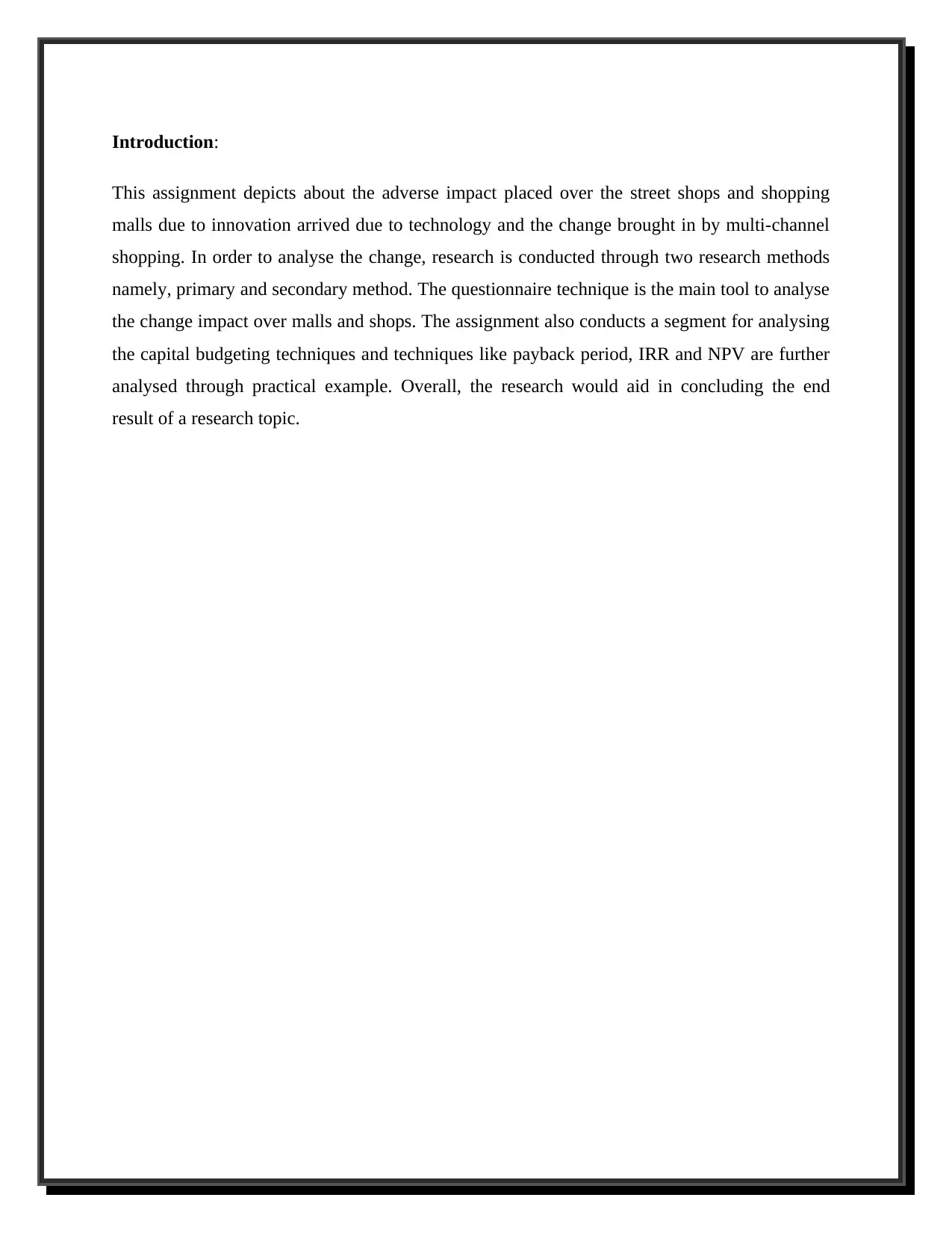
Introduction:
This assignment depicts about the adverse impact placed over the street shops and shopping
malls due to innovation arrived due to technology and the change brought in by multi-channel
shopping. In order to analyse the change, research is conducted through two research methods
namely, primary and secondary method. The questionnaire technique is the main tool to analyse
the change impact over malls and shops. The assignment also conducts a segment for analysing
the capital budgeting techniques and techniques like payback period, IRR and NPV are further
analysed through practical example. Overall, the research would aid in concluding the end
result of a research topic.
This assignment depicts about the adverse impact placed over the street shops and shopping
malls due to innovation arrived due to technology and the change brought in by multi-channel
shopping. In order to analyse the change, research is conducted through two research methods
namely, primary and secondary method. The questionnaire technique is the main tool to analyse
the change impact over malls and shops. The assignment also conducts a segment for analysing
the capital budgeting techniques and techniques like payback period, IRR and NPV are further
analysed through practical example. Overall, the research would aid in concluding the end
result of a research topic.
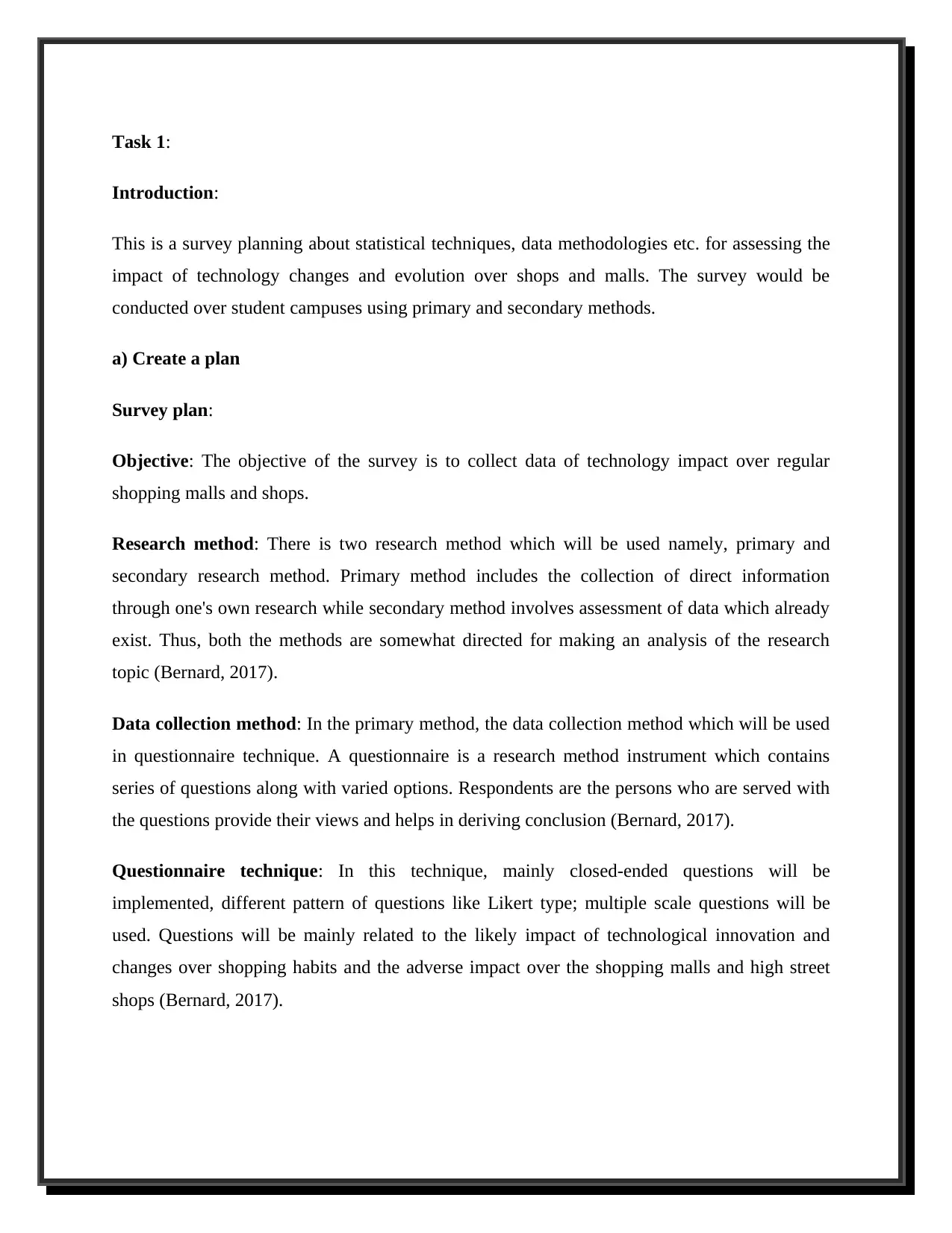
Task 1:
Introduction:
This is a survey planning about statistical techniques, data methodologies etc. for assessing the
impact of technology changes and evolution over shops and malls. The survey would be
conducted over student campuses using primary and secondary methods.
a) Create a plan
Survey plan:
Objective: The objective of the survey is to collect data of technology impact over regular
shopping malls and shops.
Research method: There is two research method which will be used namely, primary and
secondary research method. Primary method includes the collection of direct information
through one's own research while secondary method involves assessment of data which already
exist. Thus, both the methods are somewhat directed for making an analysis of the research
topic (Bernard, 2017).
Data collection method: In the primary method, the data collection method which will be used
in questionnaire technique. A questionnaire is a research method instrument which contains
series of questions along with varied options. Respondents are the persons who are served with
the questions provide their views and helps in deriving conclusion (Bernard, 2017).
Questionnaire technique: In this technique, mainly closed-ended questions will be
implemented, different pattern of questions like Likert type; multiple scale questions will be
used. Questions will be mainly related to the likely impact of technological innovation and
changes over shopping habits and the adverse impact over the shopping malls and high street
shops (Bernard, 2017).
Introduction:
This is a survey planning about statistical techniques, data methodologies etc. for assessing the
impact of technology changes and evolution over shops and malls. The survey would be
conducted over student campuses using primary and secondary methods.
a) Create a plan
Survey plan:
Objective: The objective of the survey is to collect data of technology impact over regular
shopping malls and shops.
Research method: There is two research method which will be used namely, primary and
secondary research method. Primary method includes the collection of direct information
through one's own research while secondary method involves assessment of data which already
exist. Thus, both the methods are somewhat directed for making an analysis of the research
topic (Bernard, 2017).
Data collection method: In the primary method, the data collection method which will be used
in questionnaire technique. A questionnaire is a research method instrument which contains
series of questions along with varied options. Respondents are the persons who are served with
the questions provide their views and helps in deriving conclusion (Bernard, 2017).
Questionnaire technique: In this technique, mainly closed-ended questions will be
implemented, different pattern of questions like Likert type; multiple scale questions will be
used. Questions will be mainly related to the likely impact of technological innovation and
changes over shopping habits and the adverse impact over the shopping malls and high street
shops (Bernard, 2017).
Secure Best Marks with AI Grader
Need help grading? Try our AI Grader for instant feedback on your assignments.
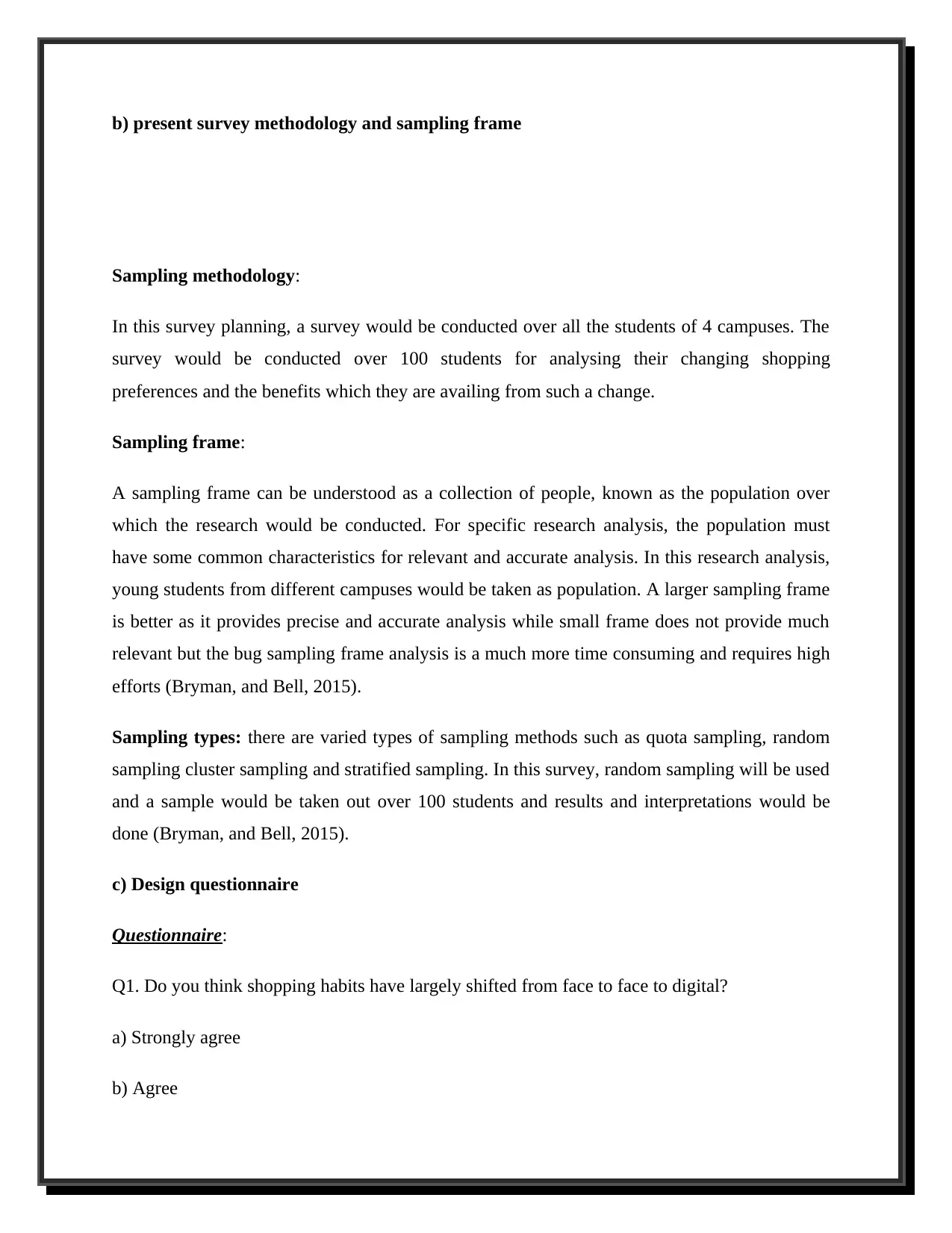
b) present survey methodology and sampling frame
Sampling methodology:
In this survey planning, a survey would be conducted over all the students of 4 campuses. The
survey would be conducted over 100 students for analysing their changing shopping
preferences and the benefits which they are availing from such a change.
Sampling frame:
A sampling frame can be understood as a collection of people, known as the population over
which the research would be conducted. For specific research analysis, the population must
have some common characteristics for relevant and accurate analysis. In this research analysis,
young students from different campuses would be taken as population. A larger sampling frame
is better as it provides precise and accurate analysis while small frame does not provide much
relevant but the bug sampling frame analysis is a much more time consuming and requires high
efforts (Bryman, and Bell, 2015).
Sampling types: there are varied types of sampling methods such as quota sampling, random
sampling cluster sampling and stratified sampling. In this survey, random sampling will be used
and a sample would be taken out over 100 students and results and interpretations would be
done (Bryman, and Bell, 2015).
c) Design questionnaire
Questionnaire:
Q1. Do you think shopping habits have largely shifted from face to face to digital?
a) Strongly agree
b) Agree
Sampling methodology:
In this survey planning, a survey would be conducted over all the students of 4 campuses. The
survey would be conducted over 100 students for analysing their changing shopping
preferences and the benefits which they are availing from such a change.
Sampling frame:
A sampling frame can be understood as a collection of people, known as the population over
which the research would be conducted. For specific research analysis, the population must
have some common characteristics for relevant and accurate analysis. In this research analysis,
young students from different campuses would be taken as population. A larger sampling frame
is better as it provides precise and accurate analysis while small frame does not provide much
relevant but the bug sampling frame analysis is a much more time consuming and requires high
efforts (Bryman, and Bell, 2015).
Sampling types: there are varied types of sampling methods such as quota sampling, random
sampling cluster sampling and stratified sampling. In this survey, random sampling will be used
and a sample would be taken out over 100 students and results and interpretations would be
done (Bryman, and Bell, 2015).
c) Design questionnaire
Questionnaire:
Q1. Do you think shopping habits have largely shifted from face to face to digital?
a) Strongly agree
b) Agree
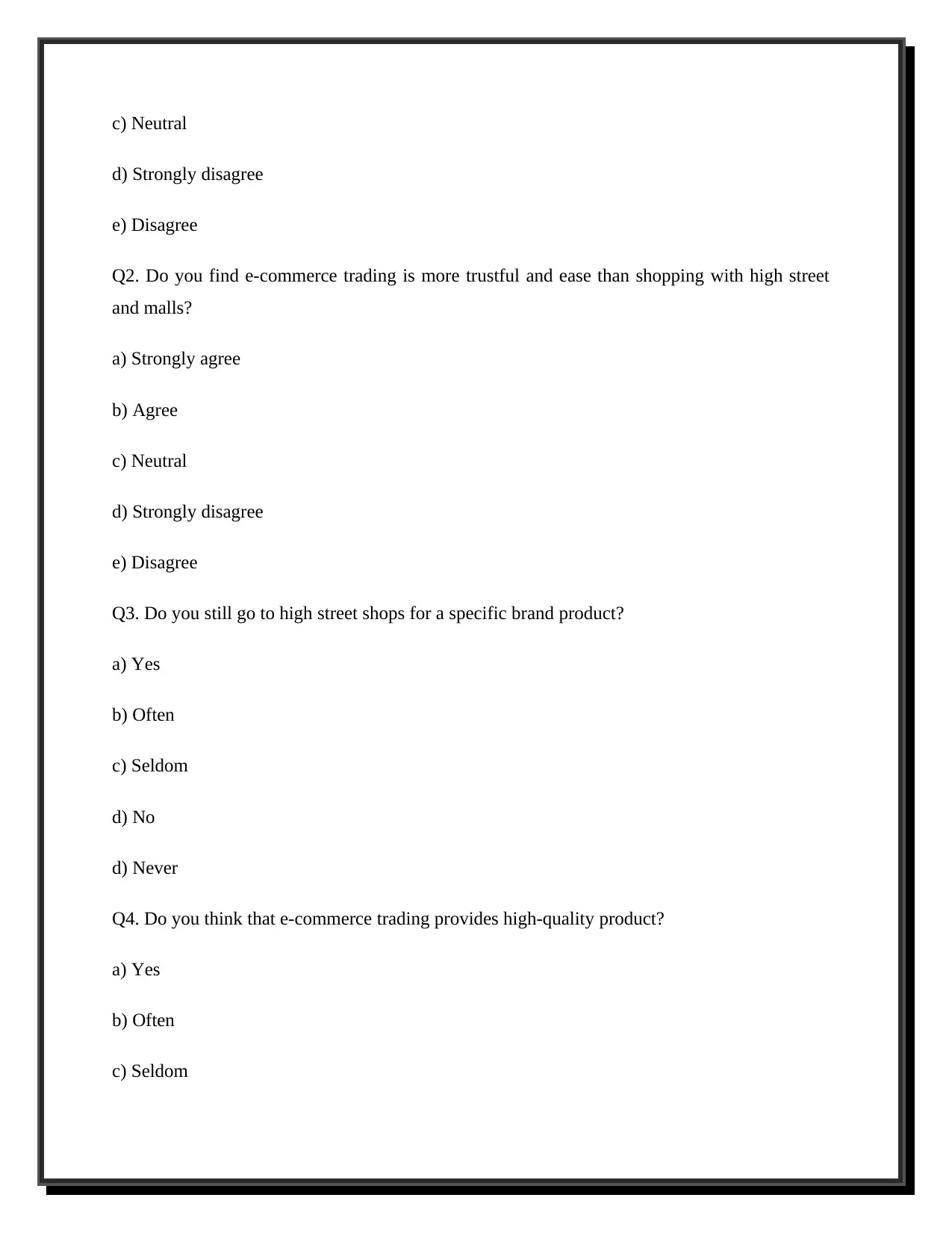
c) Neutral
d) Strongly disagree
e) Disagree
Q2. Do you find e-commerce trading is more trustful and ease than shopping with high street
and malls?
a) Strongly agree
b) Agree
c) Neutral
d) Strongly disagree
e) Disagree
Q3. Do you still go to high street shops for a specific brand product?
a) Yes
b) Often
c) Seldom
d) No
d) Never
Q4. Do you think that e-commerce trading provides high-quality product?
a) Yes
b) Often
c) Seldom
d) Strongly disagree
e) Disagree
Q2. Do you find e-commerce trading is more trustful and ease than shopping with high street
and malls?
a) Strongly agree
b) Agree
c) Neutral
d) Strongly disagree
e) Disagree
Q3. Do you still go to high street shops for a specific brand product?
a) Yes
b) Often
c) Seldom
d) No
d) Never
Q4. Do you think that e-commerce trading provides high-quality product?
a) Yes
b) Often
c) Seldom
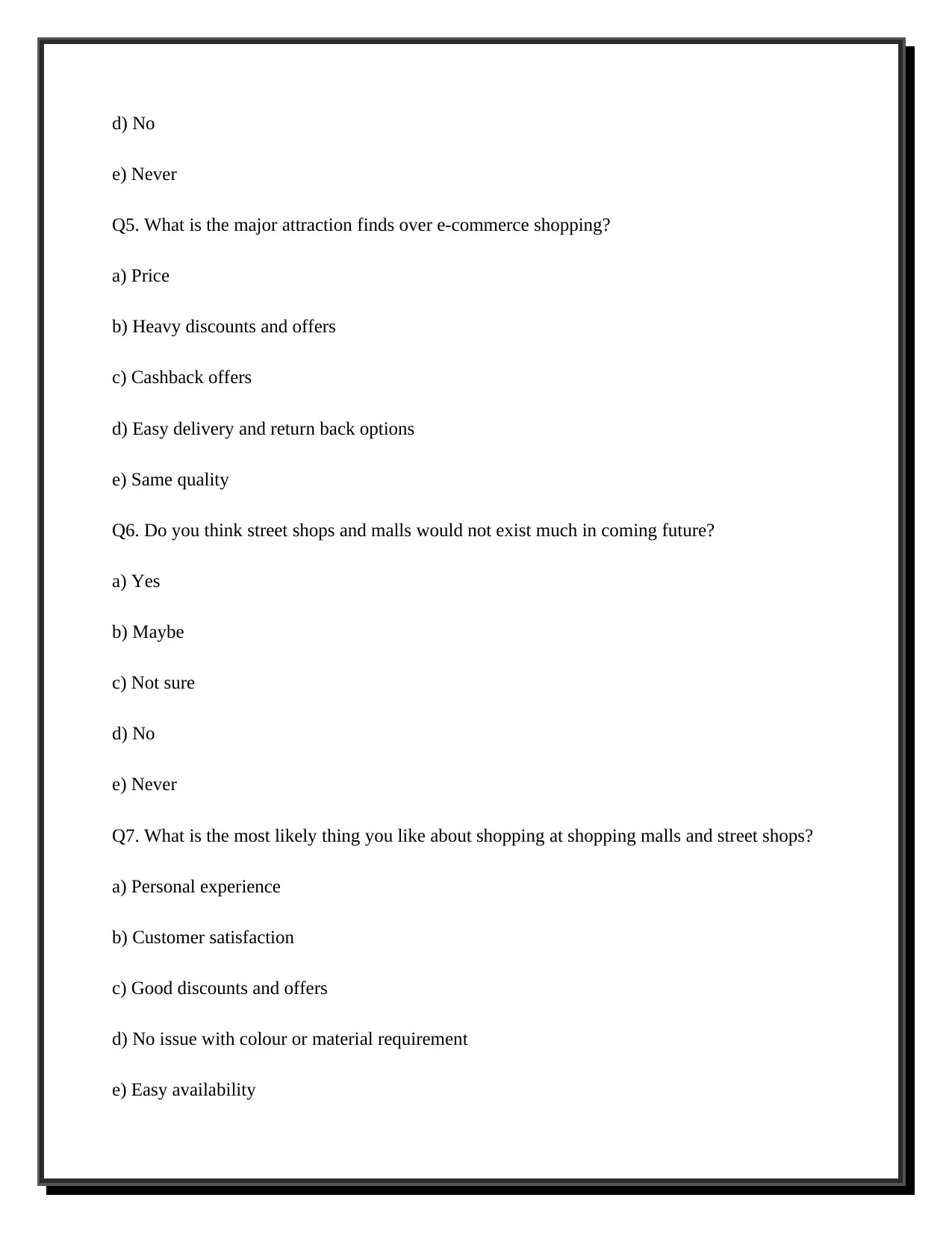
d) No
e) Never
Q5. What is the major attraction finds over e-commerce shopping?
a) Price
b) Heavy discounts and offers
c) Cashback offers
d) Easy delivery and return back options
e) Same quality
Q6. Do you think street shops and malls would not exist much in coming future?
a) Yes
b) Maybe
c) Not sure
d) No
e) Never
Q7. What is the most likely thing you like about shopping at shopping malls and street shops?
a) Personal experience
b) Customer satisfaction
c) Good discounts and offers
d) No issue with colour or material requirement
e) Easy availability
e) Never
Q5. What is the major attraction finds over e-commerce shopping?
a) Price
b) Heavy discounts and offers
c) Cashback offers
d) Easy delivery and return back options
e) Same quality
Q6. Do you think street shops and malls would not exist much in coming future?
a) Yes
b) Maybe
c) Not sure
d) No
e) Never
Q7. What is the most likely thing you like about shopping at shopping malls and street shops?
a) Personal experience
b) Customer satisfaction
c) Good discounts and offers
d) No issue with colour or material requirement
e) Easy availability
Paraphrase This Document
Need a fresh take? Get an instant paraphrase of this document with our AI Paraphraser
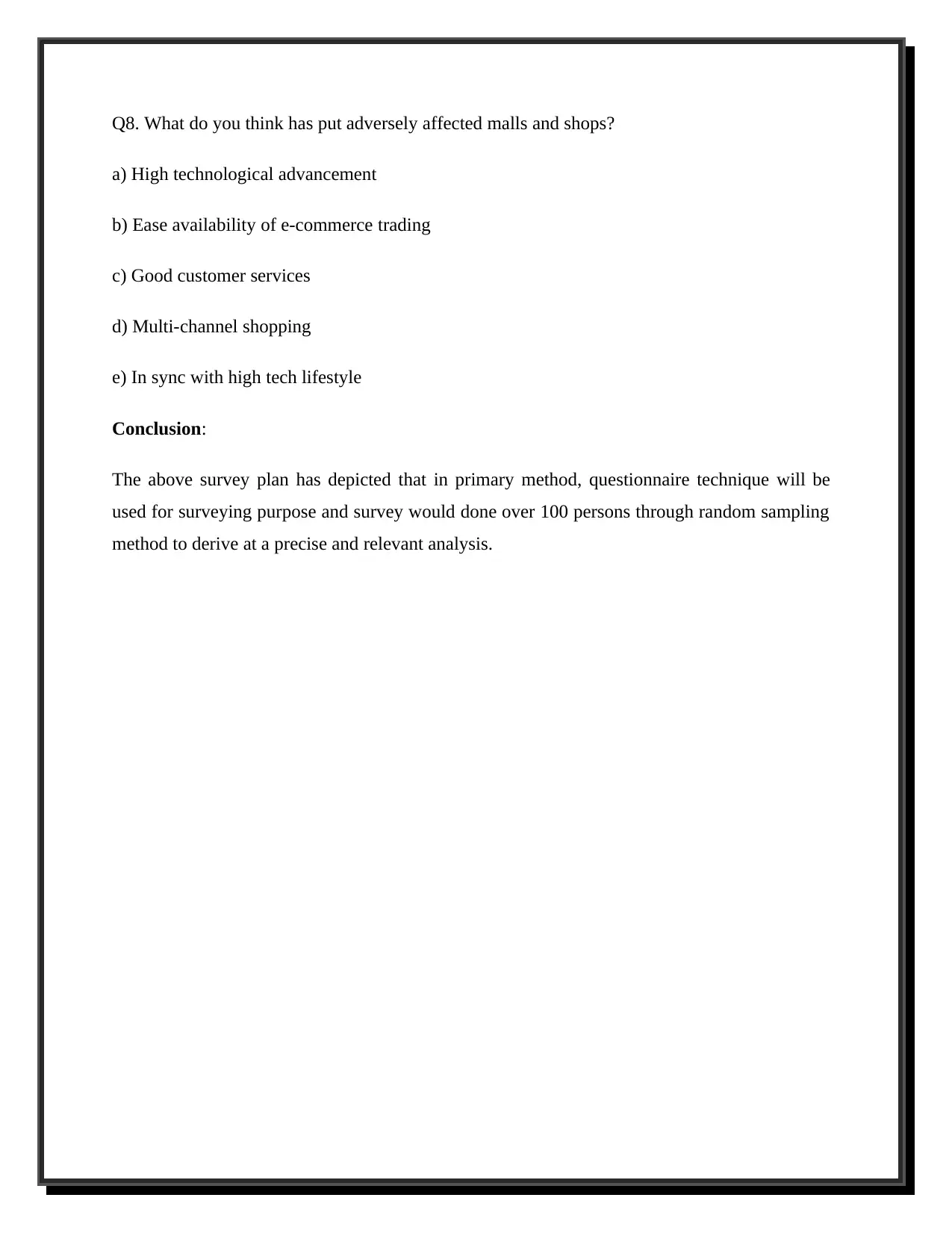
Q8. What do you think has put adversely affected malls and shops?
a) High technological advancement
b) Ease availability of e-commerce trading
c) Good customer services
d) Multi-channel shopping
e) In sync with high tech lifestyle
Conclusion:
The above survey plan has depicted that in primary method, questionnaire technique will be
used for surveying purpose and survey would done over 100 persons through random sampling
method to derive at a precise and relevant analysis.
a) High technological advancement
b) Ease availability of e-commerce trading
c) Good customer services
d) Multi-channel shopping
e) In sync with high tech lifestyle
Conclusion:
The above survey plan has depicted that in primary method, questionnaire technique will be
used for surveying purpose and survey would done over 100 persons through random sampling
method to derive at a precise and relevant analysis.
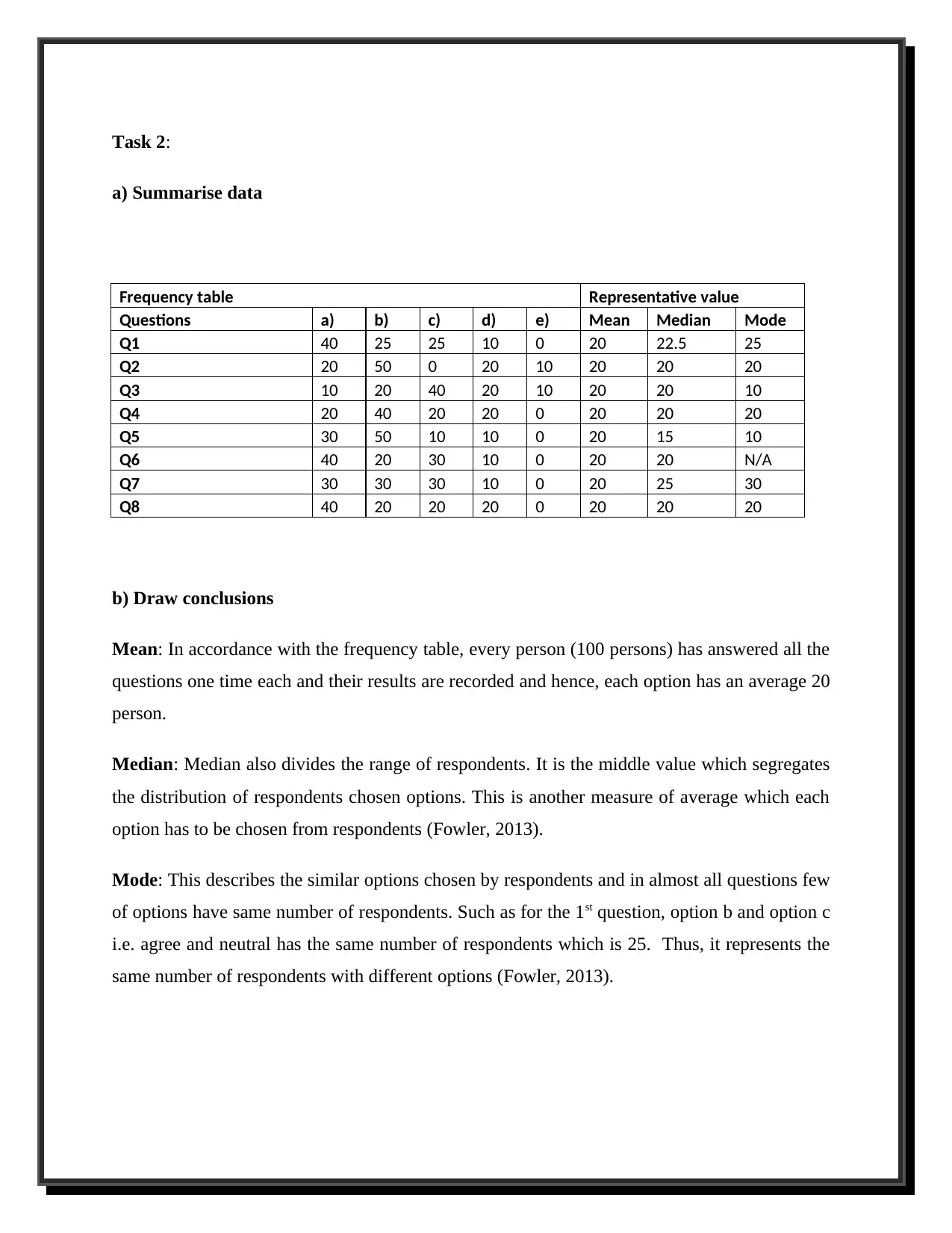
Task 2:
a) Summarise data
Frequency table Representative value
Questions a) b) c) d) e) Mean Median Mode
Q1 40 25 25 10 0 20 22.5 25
Q2 20 50 0 20 10 20 20 20
Q3 10 20 40 20 10 20 20 10
Q4 20 40 20 20 0 20 20 20
Q5 30 50 10 10 0 20 15 10
Q6 40 20 30 10 0 20 20 N/A
Q7 30 30 30 10 0 20 25 30
Q8 40 20 20 20 0 20 20 20
b) Draw conclusions
Mean: In accordance with the frequency table, every person (100 persons) has answered all the
questions one time each and their results are recorded and hence, each option has an average 20
person.
Median: Median also divides the range of respondents. It is the middle value which segregates
the distribution of respondents chosen options. This is another measure of average which each
option has to be chosen from respondents (Fowler, 2013).
Mode: This describes the similar options chosen by respondents and in almost all questions few
of options have same number of respondents. Such as for the 1st question, option b and option c
i.e. agree and neutral has the same number of respondents which is 25. Thus, it represents the
same number of respondents with different options (Fowler, 2013).
a) Summarise data
Frequency table Representative value
Questions a) b) c) d) e) Mean Median Mode
Q1 40 25 25 10 0 20 22.5 25
Q2 20 50 0 20 10 20 20 20
Q3 10 20 40 20 10 20 20 10
Q4 20 40 20 20 0 20 20 20
Q5 30 50 10 10 0 20 15 10
Q6 40 20 30 10 0 20 20 N/A
Q7 30 30 30 10 0 20 25 30
Q8 40 20 20 20 0 20 20 20
b) Draw conclusions
Mean: In accordance with the frequency table, every person (100 persons) has answered all the
questions one time each and their results are recorded and hence, each option has an average 20
person.
Median: Median also divides the range of respondents. It is the middle value which segregates
the distribution of respondents chosen options. This is another measure of average which each
option has to be chosen from respondents (Fowler, 2013).
Mode: This describes the similar options chosen by respondents and in almost all questions few
of options have same number of respondents. Such as for the 1st question, option b and option c
i.e. agree and neutral has the same number of respondents which is 25. Thus, it represents the
same number of respondents with different options (Fowler, 2013).
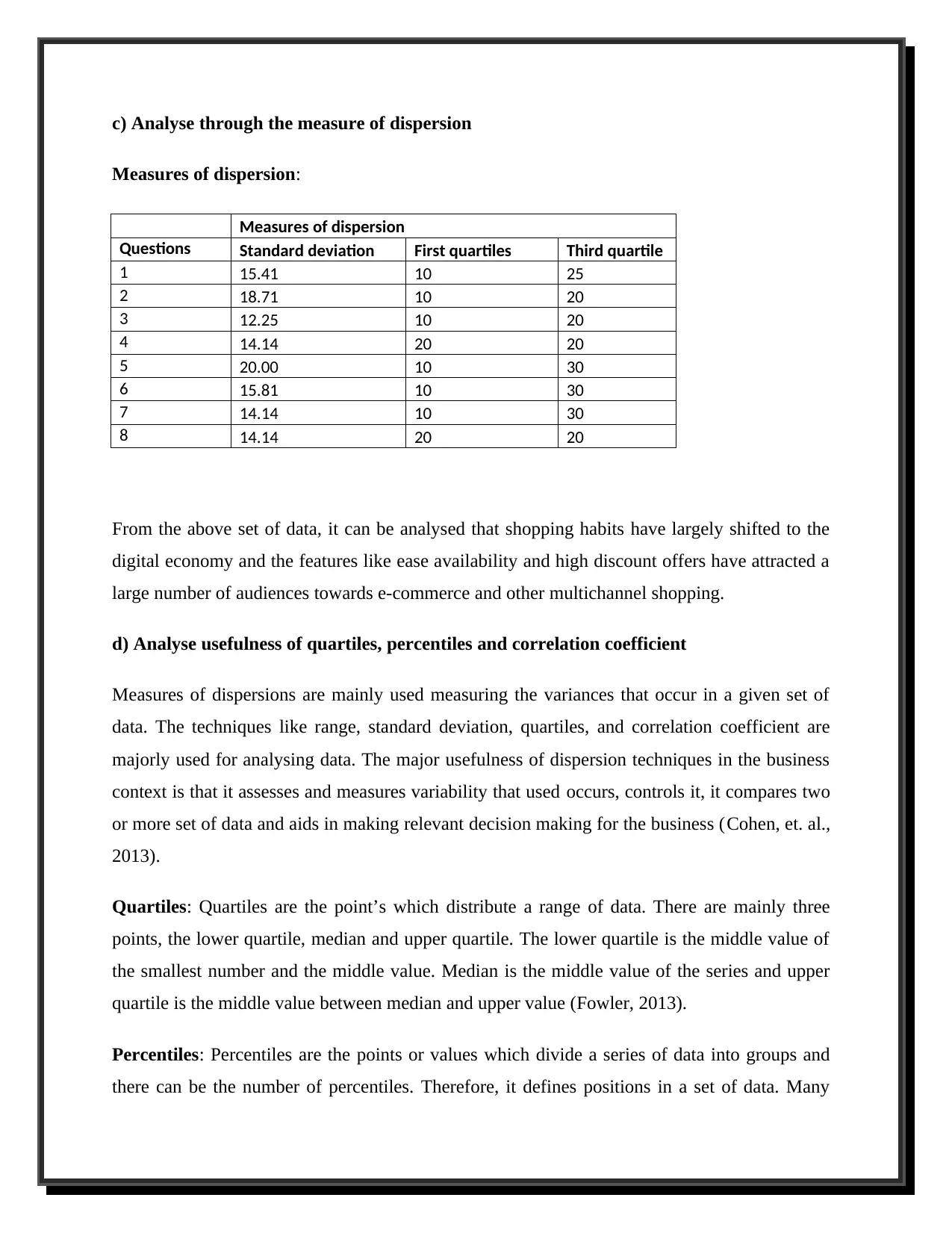
c) Analyse through the measure of dispersion
Measures of dispersion:
Measures of dispersion
Questions Standard deviation First quartiles Third quartile
1 15.41 10 25
2 18.71 10 20
3 12.25 10 20
4 14.14 20 20
5 20.00 10 30
6 15.81 10 30
7 14.14 10 30
8 14.14 20 20
From the above set of data, it can be analysed that shopping habits have largely shifted to the
digital economy and the features like ease availability and high discount offers have attracted a
large number of audiences towards e-commerce and other multichannel shopping.
d) Analyse usefulness of quartiles, percentiles and correlation coefficient
Measures of dispersions are mainly used measuring the variances that occur in a given set of
data. The techniques like range, standard deviation, quartiles, and correlation coefficient are
majorly used for analysing data. The major usefulness of dispersion techniques in the business
context is that it assesses and measures variability that used occurs, controls it, it compares two
or more set of data and aids in making relevant decision making for the business (Cohen, et. al.,
2013).
Quartiles: Quartiles are the point’s which distribute a range of data. There are mainly three
points, the lower quartile, median and upper quartile. The lower quartile is the middle value of
the smallest number and the middle value. Median is the middle value of the series and upper
quartile is the middle value between median and upper value (Fowler, 2013).
Percentiles: Percentiles are the points or values which divide a series of data into groups and
there can be the number of percentiles. Therefore, it defines positions in a set of data. Many
Measures of dispersion:
Measures of dispersion
Questions Standard deviation First quartiles Third quartile
1 15.41 10 25
2 18.71 10 20
3 12.25 10 20
4 14.14 20 20
5 20.00 10 30
6 15.81 10 30
7 14.14 10 30
8 14.14 20 20
From the above set of data, it can be analysed that shopping habits have largely shifted to the
digital economy and the features like ease availability and high discount offers have attracted a
large number of audiences towards e-commerce and other multichannel shopping.
d) Analyse usefulness of quartiles, percentiles and correlation coefficient
Measures of dispersions are mainly used measuring the variances that occur in a given set of
data. The techniques like range, standard deviation, quartiles, and correlation coefficient are
majorly used for analysing data. The major usefulness of dispersion techniques in the business
context is that it assesses and measures variability that used occurs, controls it, it compares two
or more set of data and aids in making relevant decision making for the business (Cohen, et. al.,
2013).
Quartiles: Quartiles are the point’s which distribute a range of data. There are mainly three
points, the lower quartile, median and upper quartile. The lower quartile is the middle value of
the smallest number and the middle value. Median is the middle value of the series and upper
quartile is the middle value between median and upper value (Fowler, 2013).
Percentiles: Percentiles are the points or values which divide a series of data into groups and
there can be the number of percentiles. Therefore, it defines positions in a set of data. Many
Secure Best Marks with AI Grader
Need help grading? Try our AI Grader for instant feedback on your assignments.
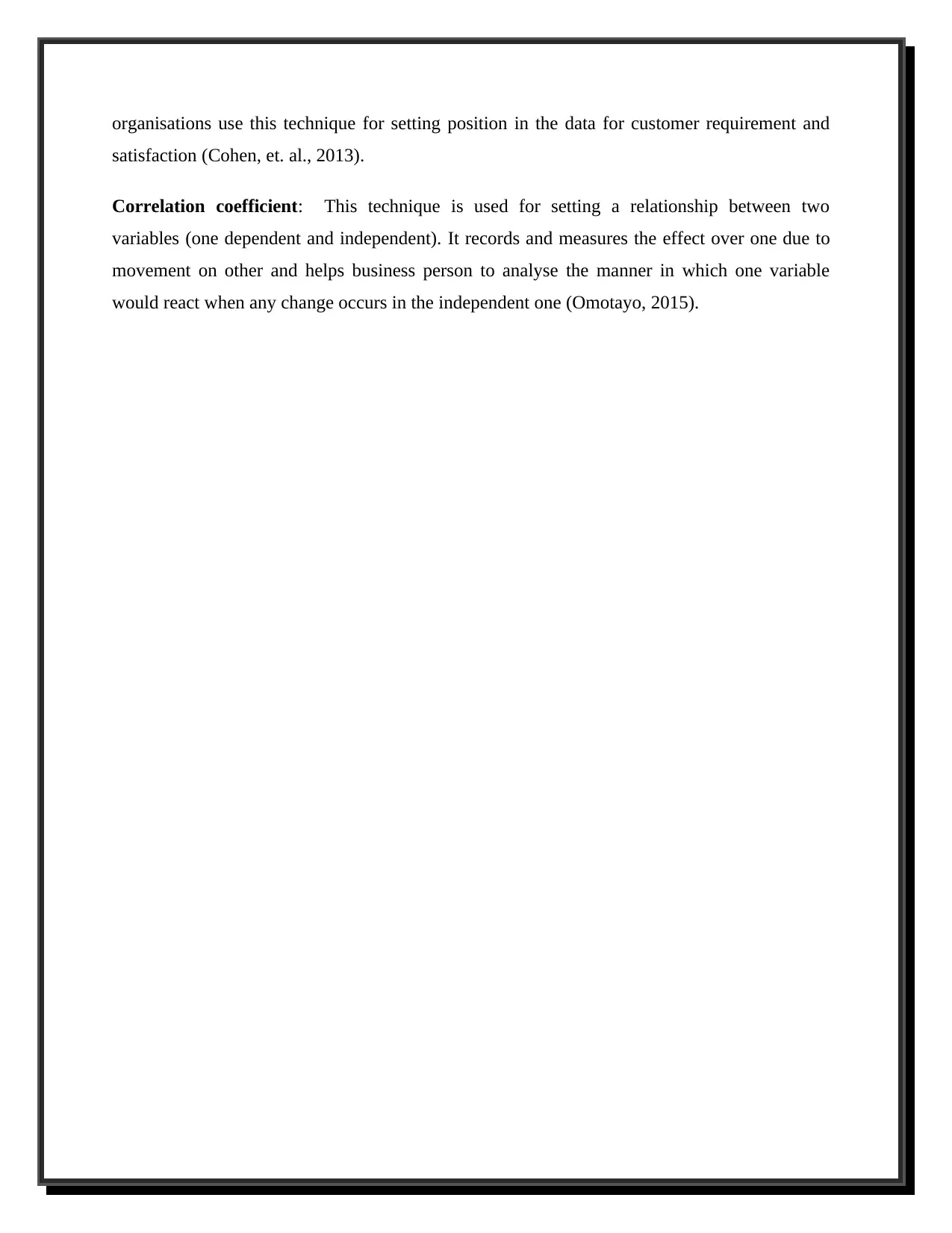
organisations use this technique for setting position in the data for customer requirement and
satisfaction (Cohen, et. al., 2013).
Correlation coefficient: This technique is used for setting a relationship between two
variables (one dependent and independent). It records and measures the effect over one due to
movement on other and helps business person to analyse the manner in which one variable
would react when any change occurs in the independent one (Omotayo, 2015).
satisfaction (Cohen, et. al., 2013).
Correlation coefficient: This technique is used for setting a relationship between two
variables (one dependent and independent). It records and measures the effect over one due to
movement on other and helps business person to analyse the manner in which one variable
would react when any change occurs in the independent one (Omotayo, 2015).
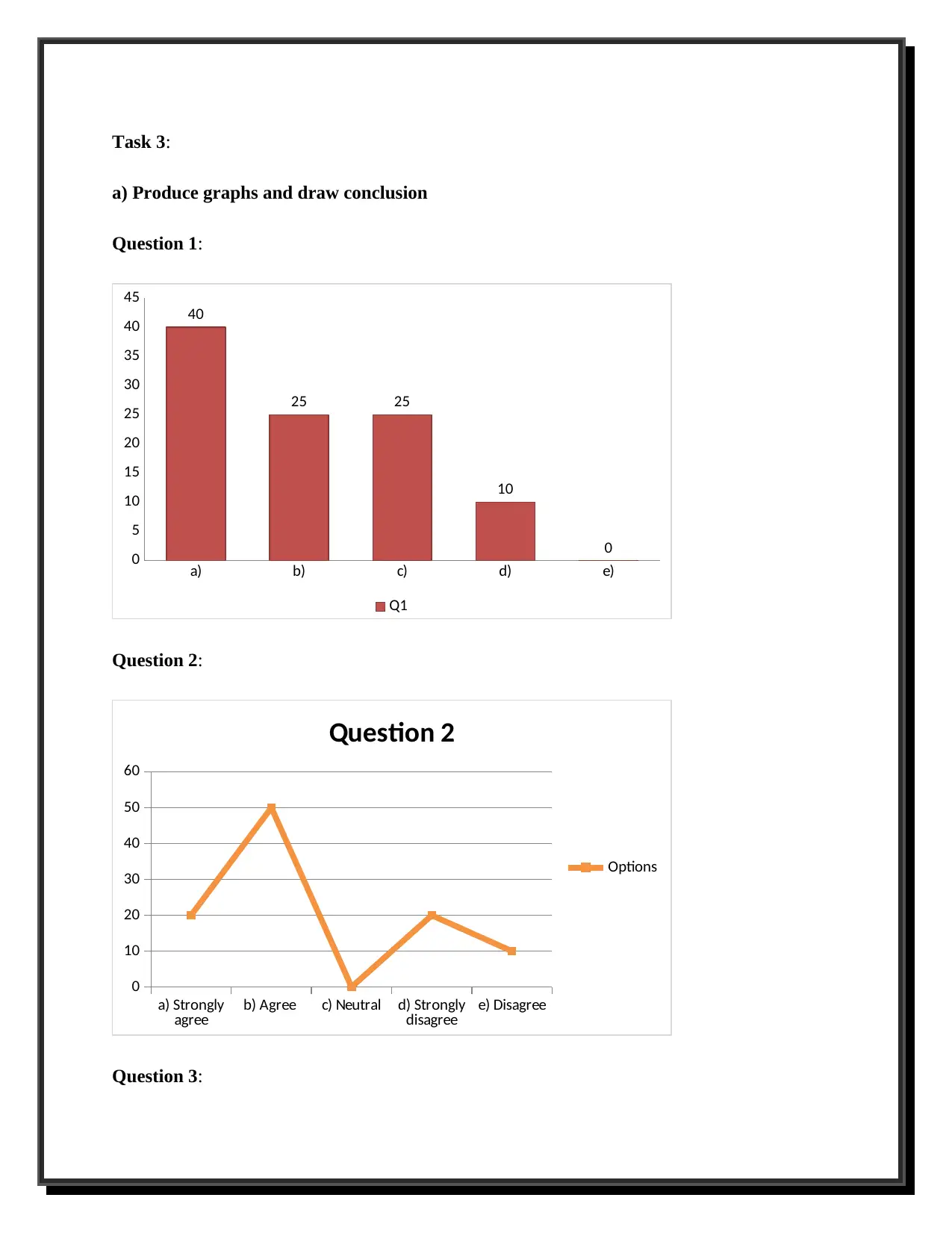
Task 3:
a) Produce graphs and draw conclusion
Question 1:
a) b) c) d) e)
0
5
10
15
20
25
30
35
40
45
40
25 25
10
0
Q1
Question 2:
a) Strongly
agree b) Agree c) Neutral d) Strongly
disagree e) Disagree
0
10
20
30
40
50
60
Question 2
Options
Question 3:
a) Produce graphs and draw conclusion
Question 1:
a) b) c) d) e)
0
5
10
15
20
25
30
35
40
45
40
25 25
10
0
Q1
Question 2:
a) Strongly
agree b) Agree c) Neutral d) Strongly
disagree e) Disagree
0
10
20
30
40
50
60
Question 2
Options
Question 3:
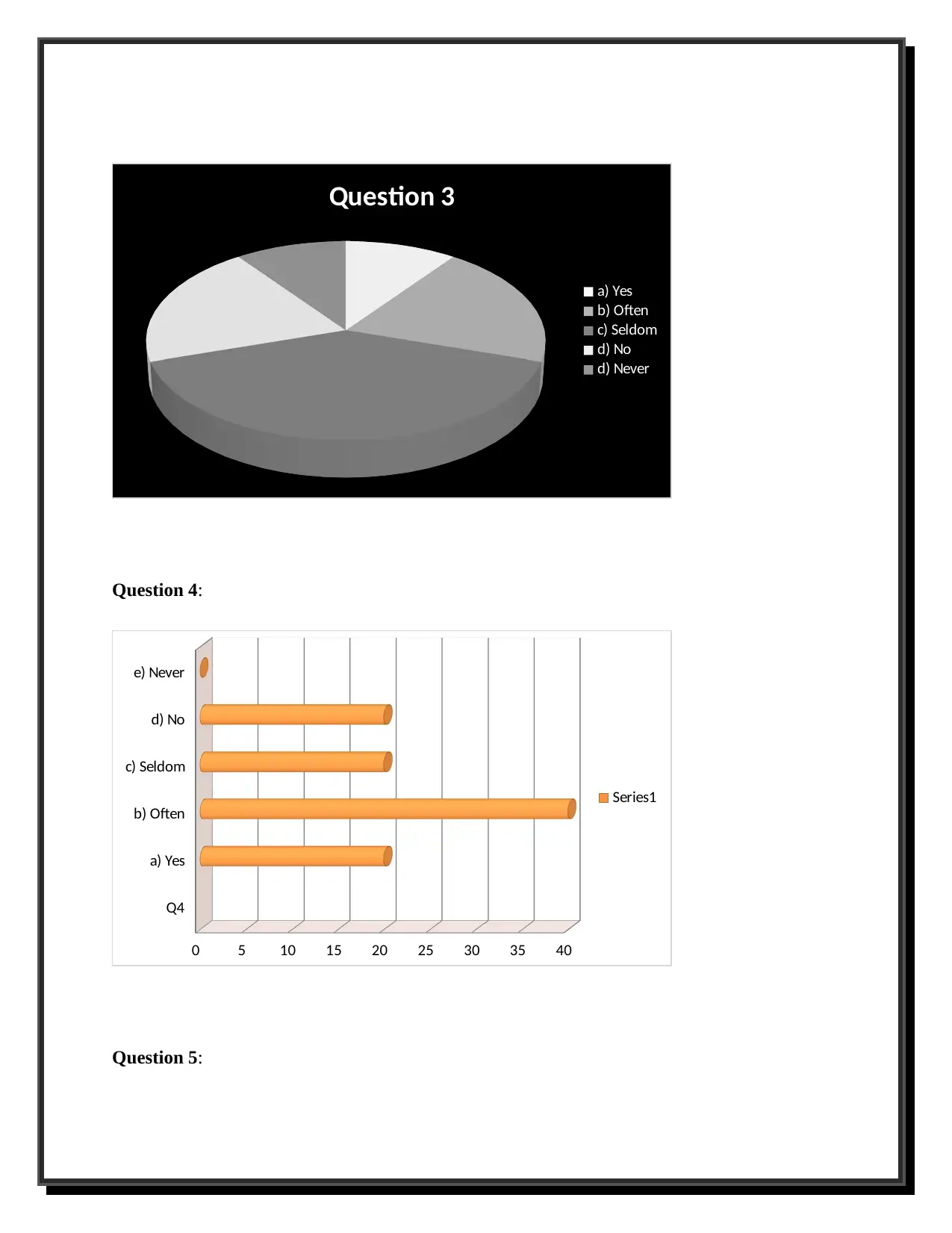
Question 3
a) Yes
b) Often
c) Seldom
d) No
d) Never
Question 4:
Q4
a) Yes
b) Often
c) Seldom
d) No
e) Never
0 5 10 15 20 25 30 35 40
Series1
Question 5:
a) Yes
b) Often
c) Seldom
d) No
d) Never
Question 4:
Q4
a) Yes
b) Often
c) Seldom
d) No
e) Never
0 5 10 15 20 25 30 35 40
Series1
Question 5:
Paraphrase This Document
Need a fresh take? Get an instant paraphrase of this document with our AI Paraphraser
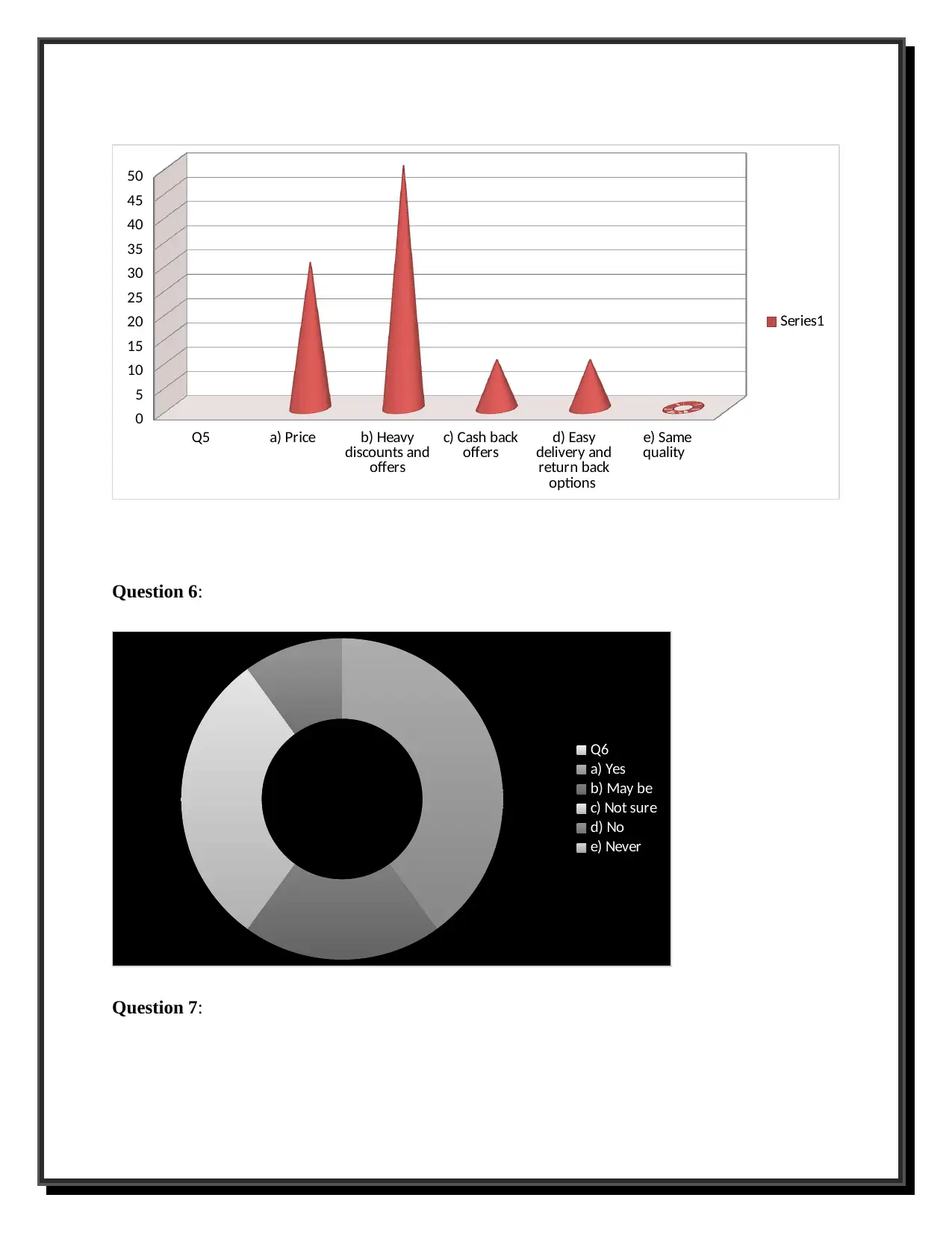
Q5 a) Price b) Heavy
discounts and
offers
c) Cash back
offers d) Easy
delivery and
return back
options
e) Same
quality
0
5
10
15
20
25
30
35
40
45
50
Series1
Question 6:
Q6
a) Yes
b) May be
c) Not sure
d) No
e) Never
Question 7:
discounts and
offers
c) Cash back
offers d) Easy
delivery and
return back
options
e) Same
quality
0
5
10
15
20
25
30
35
40
45
50
Series1
Question 6:
Q6
a) Yes
b) May be
c) Not sure
d) No
e) Never
Question 7:
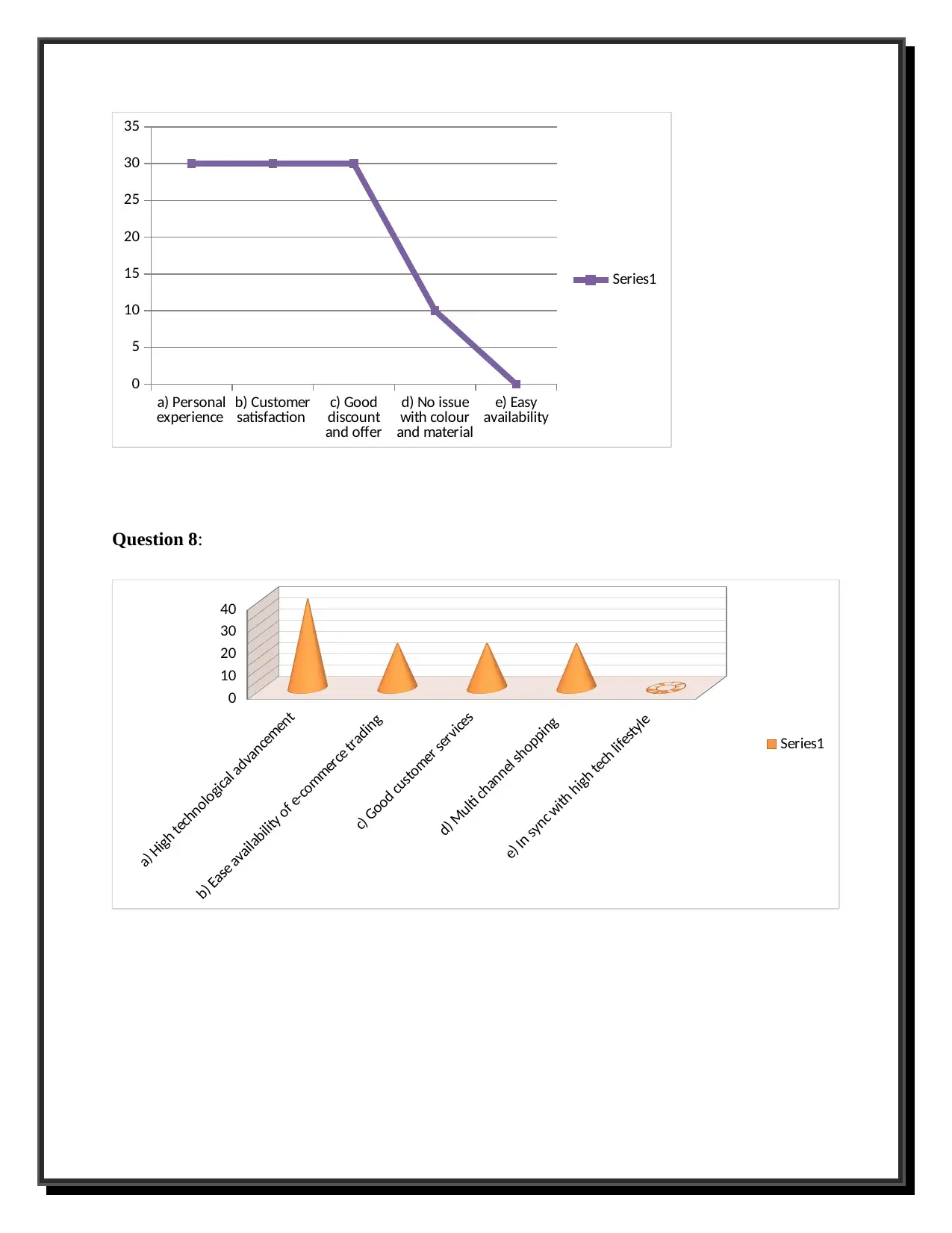
a) Personal
experience b) Customer
satisfaction c) Good
discount
and offer
d) No issue
with colour
and material
e) Easy
availability
0
5
10
15
20
25
30
35
Series1
Question 8:
a) High technological advancement
b) Ease availability of e-commerce trading
c) Good customer services
d) Multi channel shopping
e) In sync with high tech lifestyle
0
10
20
30
40
Series1
experience b) Customer
satisfaction c) Good
discount
and offer
d) No issue
with colour
and material
e) Easy
availability
0
5
10
15
20
25
30
35
Series1
Question 8:
a) High technological advancement
b) Ease availability of e-commerce trading
c) Good customer services
d) Multi channel shopping
e) In sync with high tech lifestyle
0
10
20
30
40
Series1
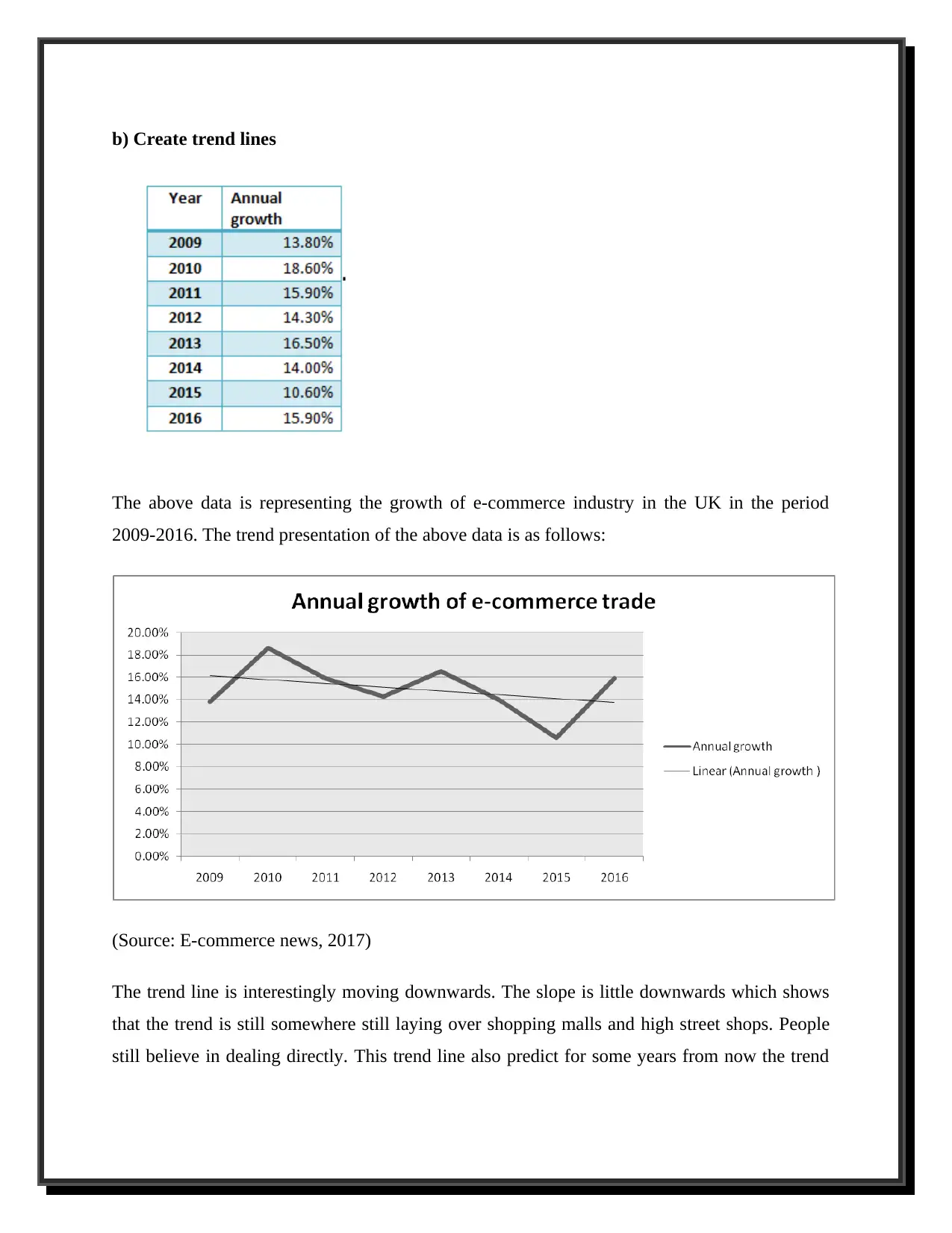
b) Create trend lines
The above data is representing the growth of e-commerce industry in the UK in the period
2009-2016. The trend presentation of the above data is as follows:
(Source: E-commerce news, 2017)
The trend line is interestingly moving downwards. The slope is little downwards which shows
that the trend is still somewhere still laying over shopping malls and high street shops. People
still believe in dealing directly. This trend line also predict for some years from now the trend
The above data is representing the growth of e-commerce industry in the UK in the period
2009-2016. The trend presentation of the above data is as follows:
(Source: E-commerce news, 2017)
The trend line is interestingly moving downwards. The slope is little downwards which shows
that the trend is still somewhere still laying over shopping malls and high street shops. People
still believe in dealing directly. This trend line also predict for some years from now the trend
Secure Best Marks with AI Grader
Need help grading? Try our AI Grader for instant feedback on your assignments.
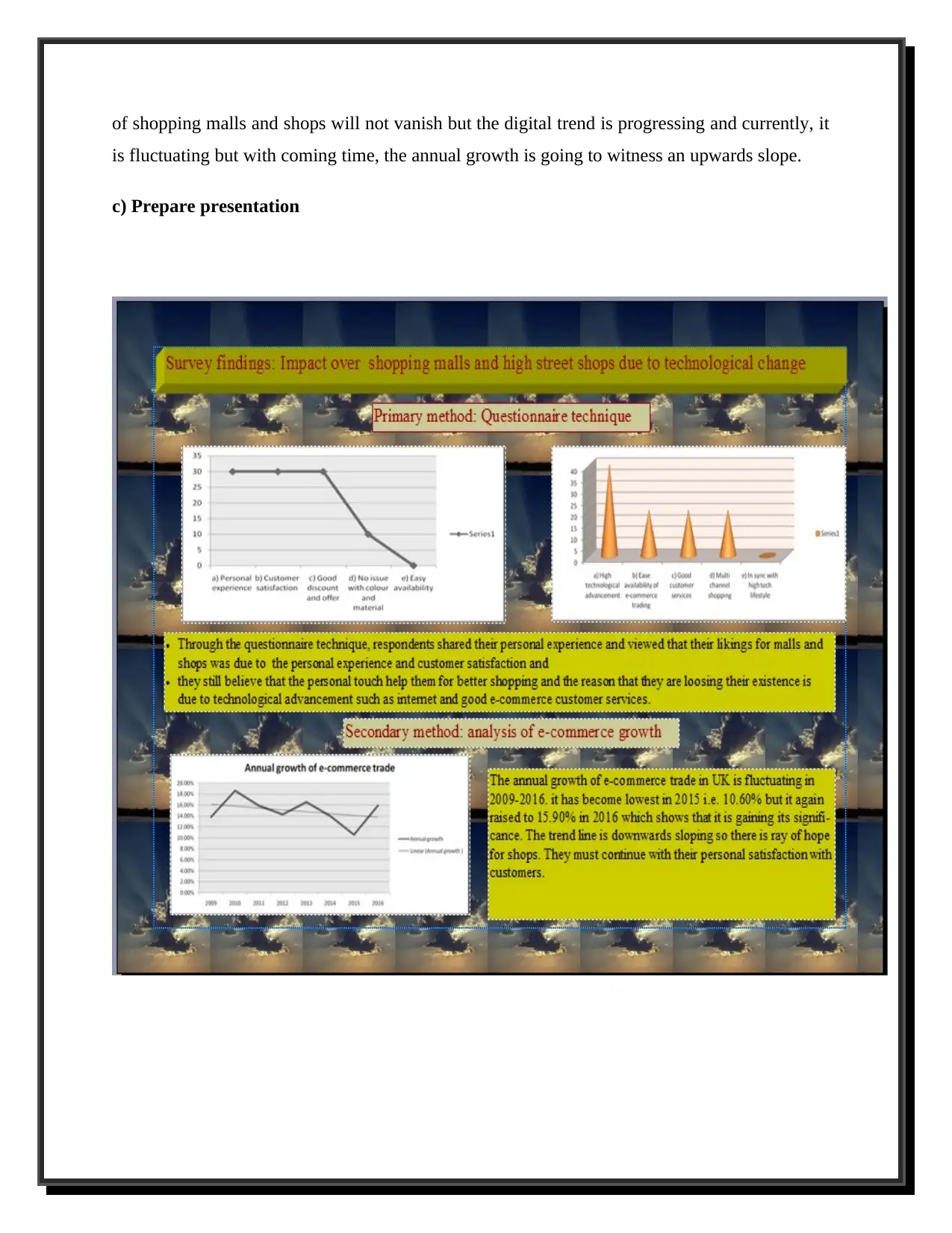
of shopping malls and shops will not vanish but the digital trend is progressing and currently, it
is fluctuating but with coming time, the annual growth is going to witness an upwards slope.
c) Prepare presentation
is fluctuating but with coming time, the annual growth is going to witness an upwards slope.
c) Prepare presentation
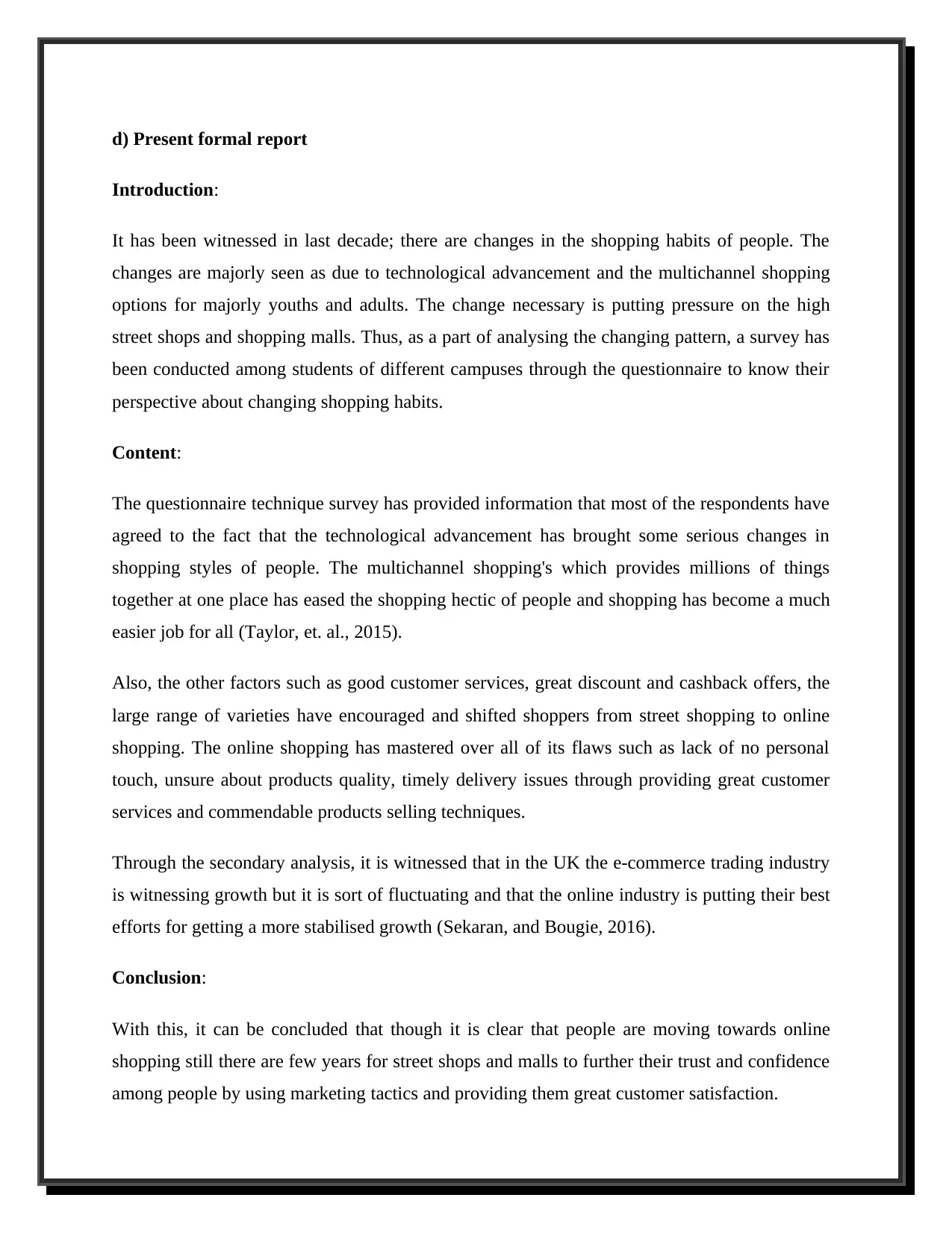
d) Present formal report
Introduction:
It has been witnessed in last decade; there are changes in the shopping habits of people. The
changes are majorly seen as due to technological advancement and the multichannel shopping
options for majorly youths and adults. The change necessary is putting pressure on the high
street shops and shopping malls. Thus, as a part of analysing the changing pattern, a survey has
been conducted among students of different campuses through the questionnaire to know their
perspective about changing shopping habits.
Content:
The questionnaire technique survey has provided information that most of the respondents have
agreed to the fact that the technological advancement has brought some serious changes in
shopping styles of people. The multichannel shopping's which provides millions of things
together at one place has eased the shopping hectic of people and shopping has become a much
easier job for all (Taylor, et. al., 2015).
Also, the other factors such as good customer services, great discount and cashback offers, the
large range of varieties have encouraged and shifted shoppers from street shopping to online
shopping. The online shopping has mastered over all of its flaws such as lack of no personal
touch, unsure about products quality, timely delivery issues through providing great customer
services and commendable products selling techniques.
Through the secondary analysis, it is witnessed that in the UK the e-commerce trading industry
is witnessing growth but it is sort of fluctuating and that the online industry is putting their best
efforts for getting a more stabilised growth (Sekaran, and Bougie, 2016).
Conclusion:
With this, it can be concluded that though it is clear that people are moving towards online
shopping still there are few years for street shops and malls to further their trust and confidence
among people by using marketing tactics and providing them great customer satisfaction.
Introduction:
It has been witnessed in last decade; there are changes in the shopping habits of people. The
changes are majorly seen as due to technological advancement and the multichannel shopping
options for majorly youths and adults. The change necessary is putting pressure on the high
street shops and shopping malls. Thus, as a part of analysing the changing pattern, a survey has
been conducted among students of different campuses through the questionnaire to know their
perspective about changing shopping habits.
Content:
The questionnaire technique survey has provided information that most of the respondents have
agreed to the fact that the technological advancement has brought some serious changes in
shopping styles of people. The multichannel shopping's which provides millions of things
together at one place has eased the shopping hectic of people and shopping has become a much
easier job for all (Taylor, et. al., 2015).
Also, the other factors such as good customer services, great discount and cashback offers, the
large range of varieties have encouraged and shifted shoppers from street shopping to online
shopping. The online shopping has mastered over all of its flaws such as lack of no personal
touch, unsure about products quality, timely delivery issues through providing great customer
services and commendable products selling techniques.
Through the secondary analysis, it is witnessed that in the UK the e-commerce trading industry
is witnessing growth but it is sort of fluctuating and that the online industry is putting their best
efforts for getting a more stabilised growth (Sekaran, and Bougie, 2016).
Conclusion:
With this, it can be concluded that though it is clear that people are moving towards online
shopping still there are few years for street shops and malls to further their trust and confidence
among people by using marketing tactics and providing them great customer satisfaction.
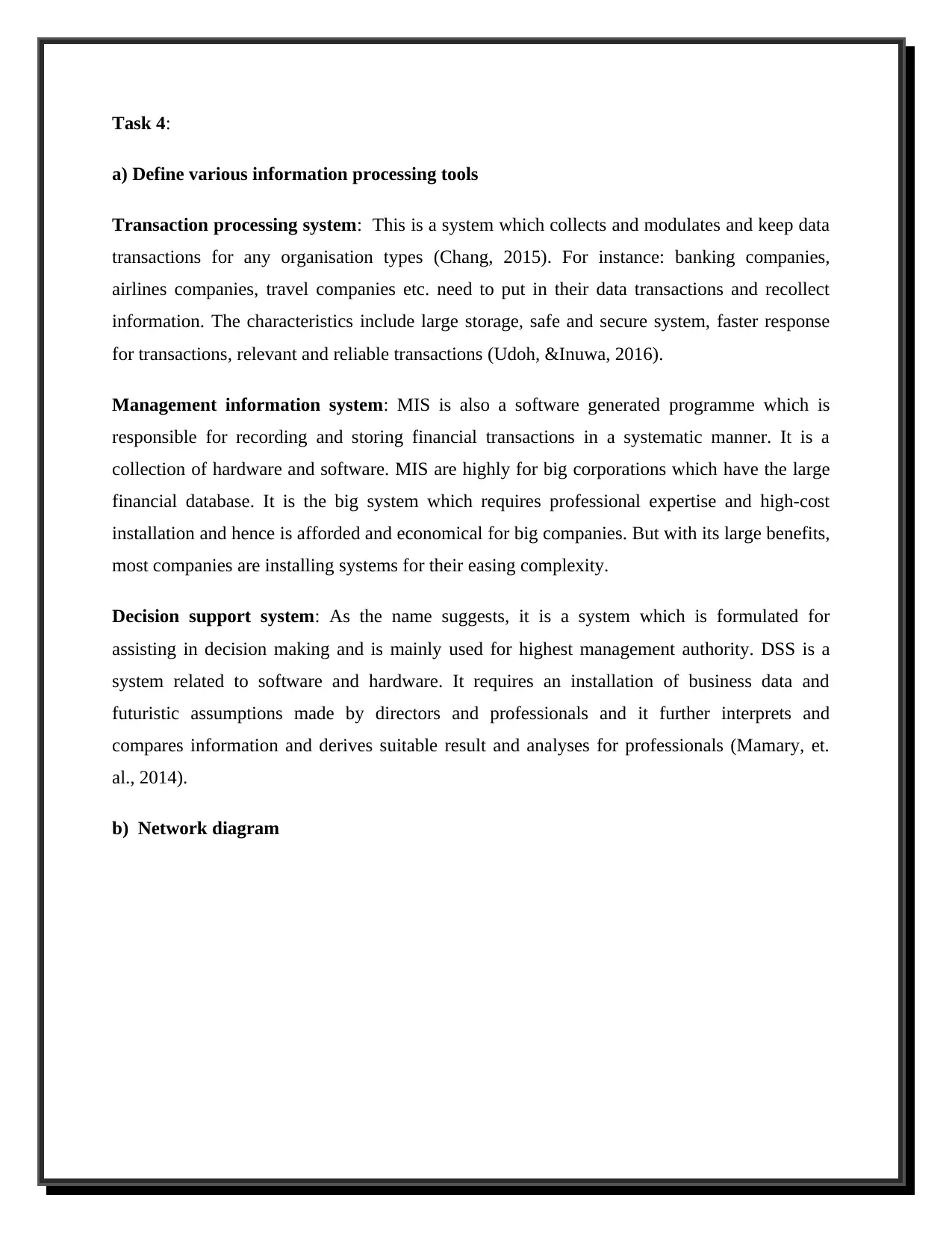
Task 4:
a) Define various information processing tools
Transaction processing system: This is a system which collects and modulates and keep data
transactions for any organisation types (Chang, 2015). For instance: banking companies,
airlines companies, travel companies etc. need to put in their data transactions and recollect
information. The characteristics include large storage, safe and secure system, faster response
for transactions, relevant and reliable transactions (Udoh, &Inuwa, 2016).
Management information system: MIS is also a software generated programme which is
responsible for recording and storing financial transactions in a systematic manner. It is a
collection of hardware and software. MIS are highly for big corporations which have the large
financial database. It is the big system which requires professional expertise and high-cost
installation and hence is afforded and economical for big companies. But with its large benefits,
most companies are installing systems for their easing complexity.
Decision support system: As the name suggests, it is a system which is formulated for
assisting in decision making and is mainly used for highest management authority. DSS is a
system related to software and hardware. It requires an installation of business data and
futuristic assumptions made by directors and professionals and it further interprets and
compares information and derives suitable result and analyses for professionals (Mamary, et.
al., 2014).
b) Network diagram
a) Define various information processing tools
Transaction processing system: This is a system which collects and modulates and keep data
transactions for any organisation types (Chang, 2015). For instance: banking companies,
airlines companies, travel companies etc. need to put in their data transactions and recollect
information. The characteristics include large storage, safe and secure system, faster response
for transactions, relevant and reliable transactions (Udoh, &Inuwa, 2016).
Management information system: MIS is also a software generated programme which is
responsible for recording and storing financial transactions in a systematic manner. It is a
collection of hardware and software. MIS are highly for big corporations which have the large
financial database. It is the big system which requires professional expertise and high-cost
installation and hence is afforded and economical for big companies. But with its large benefits,
most companies are installing systems for their easing complexity.
Decision support system: As the name suggests, it is a system which is formulated for
assisting in decision making and is mainly used for highest management authority. DSS is a
system related to software and hardware. It requires an installation of business data and
futuristic assumptions made by directors and professionals and it further interprets and
compares information and derives suitable result and analyses for professionals (Mamary, et.
al., 2014).
b) Network diagram
Paraphrase This Document
Need a fresh take? Get an instant paraphrase of this document with our AI Paraphraser
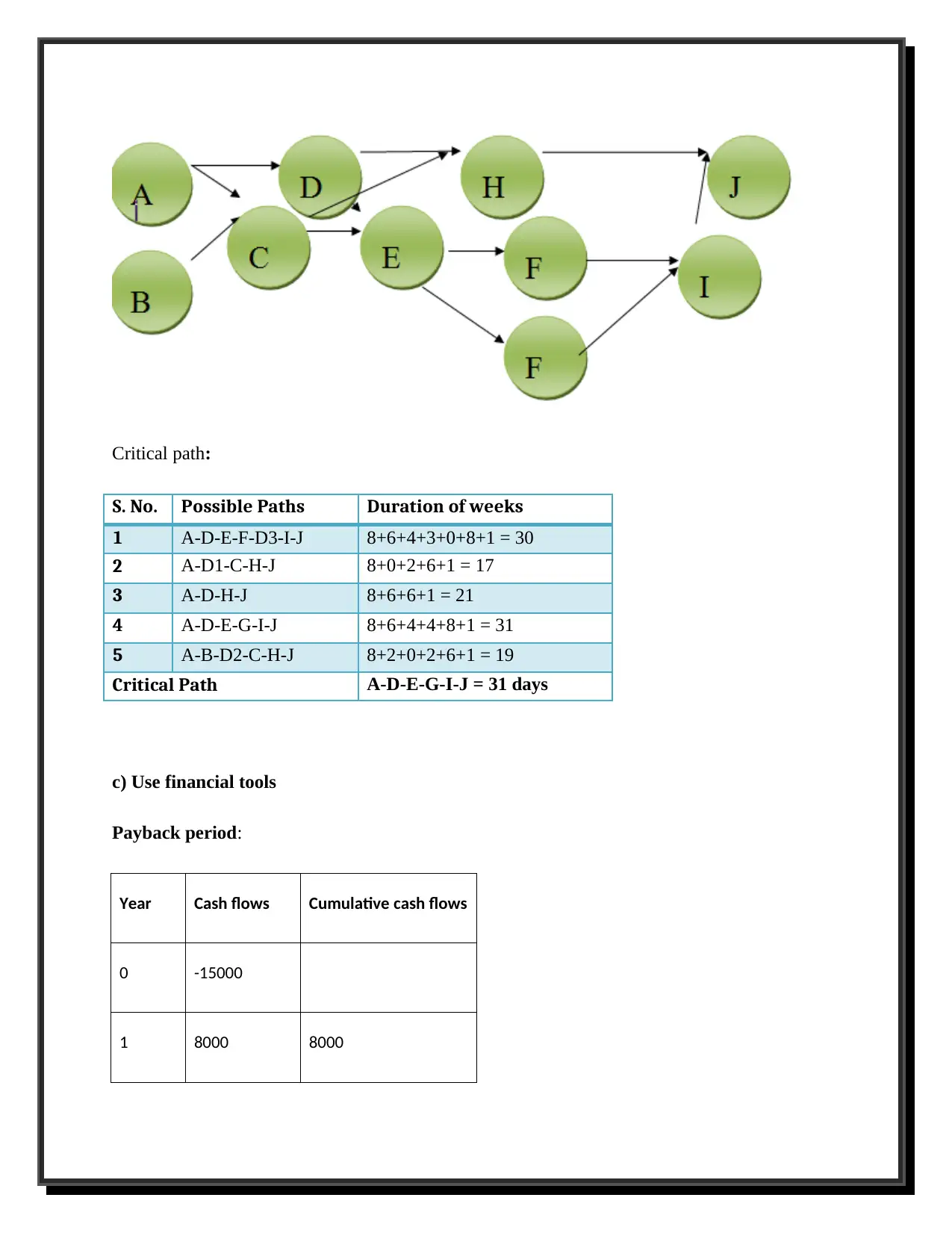
Critical path:
S. No. Possible Paths Duration of weeks
1 A-D-E-F-D3-I-J 8+6+4+3+0+8+1 = 30
2 A-D1-C-H-J 8+0+2+6+1 = 17
3 A-D-H-J 8+6+6+1 = 21
4 A-D-E-G-I-J 8+6+4+4+8+1 = 31
5 A-B-D2-C-H-J 8+2+0+2+6+1 = 19
Critical Path A-D-E-G-I-J = 31 days
c) Use financial tools
Payback period:
Year Cash flows Cumulative cash flows
0 -15000
1 8000 8000
S. No. Possible Paths Duration of weeks
1 A-D-E-F-D3-I-J 8+6+4+3+0+8+1 = 30
2 A-D1-C-H-J 8+0+2+6+1 = 17
3 A-D-H-J 8+6+6+1 = 21
4 A-D-E-G-I-J 8+6+4+4+8+1 = 31
5 A-B-D2-C-H-J 8+2+0+2+6+1 = 19
Critical Path A-D-E-G-I-J = 31 days
c) Use financial tools
Payback period:
Year Cash flows Cumulative cash flows
0 -15000
1 8000 8000
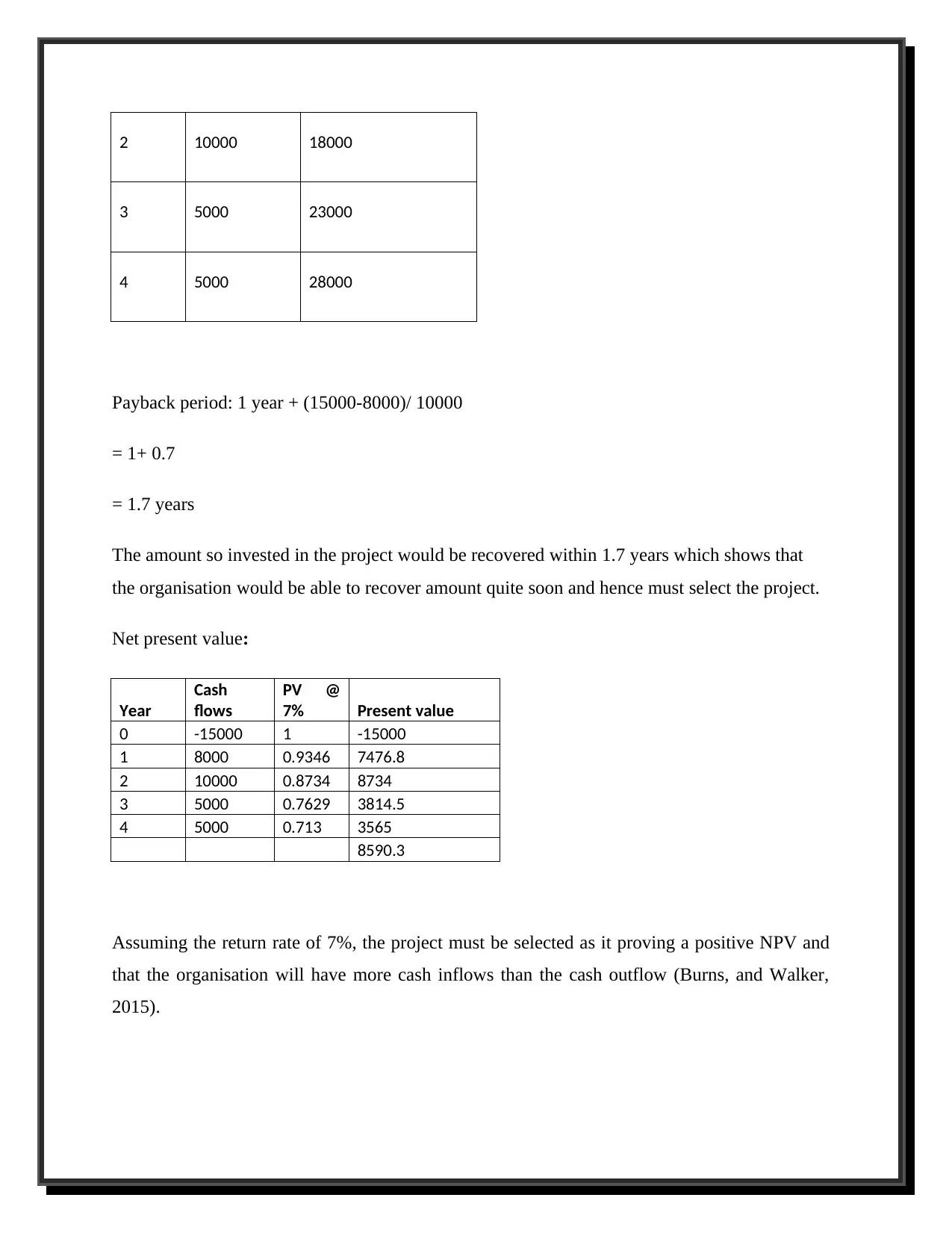
2 10000 18000
3 5000 23000
4 5000 28000
Payback period: 1 year + (15000-8000)/ 10000
= 1+ 0.7
= 1.7 years
The amount so invested in the project would be recovered within 1.7 years which shows that
the organisation would be able to recover amount quite soon and hence must select the project.
Net present value:
Year
Cash
flows
PV @
7% Present value
0 -15000 1 -15000
1 8000 0.9346 7476.8
2 10000 0.8734 8734
3 5000 0.7629 3814.5
4 5000 0.713 3565
8590.3
Assuming the return rate of 7%, the project must be selected as it proving a positive NPV and
that the organisation will have more cash inflows than the cash outflow (Burns, and Walker,
2015).
3 5000 23000
4 5000 28000
Payback period: 1 year + (15000-8000)/ 10000
= 1+ 0.7
= 1.7 years
The amount so invested in the project would be recovered within 1.7 years which shows that
the organisation would be able to recover amount quite soon and hence must select the project.
Net present value:
Year
Cash
flows
PV @
7% Present value
0 -15000 1 -15000
1 8000 0.9346 7476.8
2 10000 0.8734 8734
3 5000 0.7629 3814.5
4 5000 0.713 3565
8590.3
Assuming the return rate of 7%, the project must be selected as it proving a positive NPV and
that the organisation will have more cash inflows than the cash outflow (Burns, and Walker,
2015).
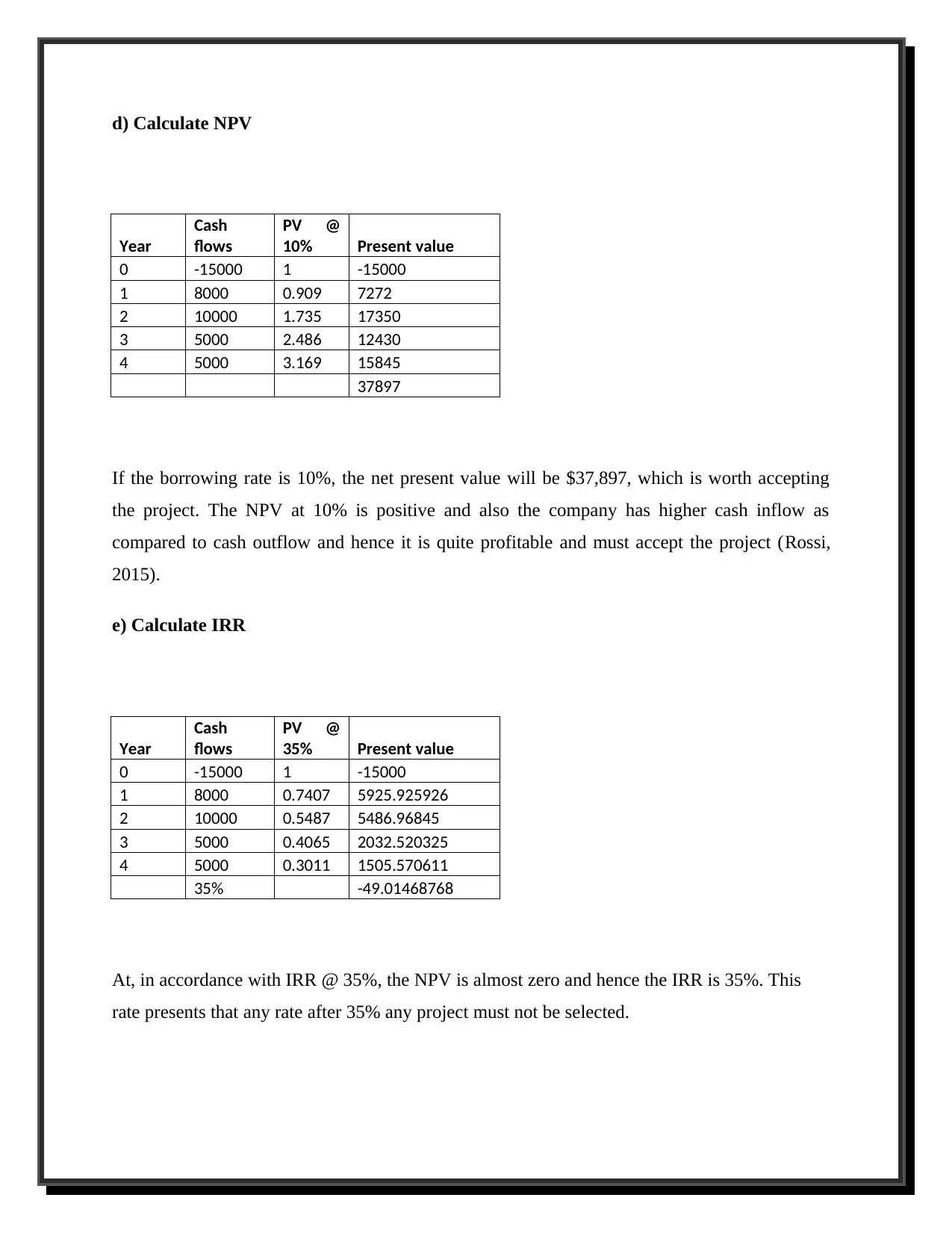
d) Calculate NPV
Year
Cash
flows
PV @
10% Present value
0 -15000 1 -15000
1 8000 0.909 7272
2 10000 1.735 17350
3 5000 2.486 12430
4 5000 3.169 15845
37897
If the borrowing rate is 10%, the net present value will be $37,897, which is worth accepting
the project. The NPV at 10% is positive and also the company has higher cash inflow as
compared to cash outflow and hence it is quite profitable and must accept the project (Rossi,
2015).
e) Calculate IRR
Year
Cash
flows
PV @
35% Present value
0 -15000 1 -15000
1 8000 0.7407 5925.925926
2 10000 0.5487 5486.96845
3 5000 0.4065 2032.520325
4 5000 0.3011 1505.570611
35% -49.01468768
At, in accordance with IRR @ 35%, the NPV is almost zero and hence the IRR is 35%. This
rate presents that any rate after 35% any project must not be selected.
Year
Cash
flows
PV @
10% Present value
0 -15000 1 -15000
1 8000 0.909 7272
2 10000 1.735 17350
3 5000 2.486 12430
4 5000 3.169 15845
37897
If the borrowing rate is 10%, the net present value will be $37,897, which is worth accepting
the project. The NPV at 10% is positive and also the company has higher cash inflow as
compared to cash outflow and hence it is quite profitable and must accept the project (Rossi,
2015).
e) Calculate IRR
Year
Cash
flows
PV @
35% Present value
0 -15000 1 -15000
1 8000 0.7407 5925.925926
2 10000 0.5487 5486.96845
3 5000 0.4065 2032.520325
4 5000 0.3011 1505.570611
35% -49.01468768
At, in accordance with IRR @ 35%, the NPV is almost zero and hence the IRR is 35%. This
rate presents that any rate after 35% any project must not be selected.
Secure Best Marks with AI Grader
Need help grading? Try our AI Grader for instant feedback on your assignments.
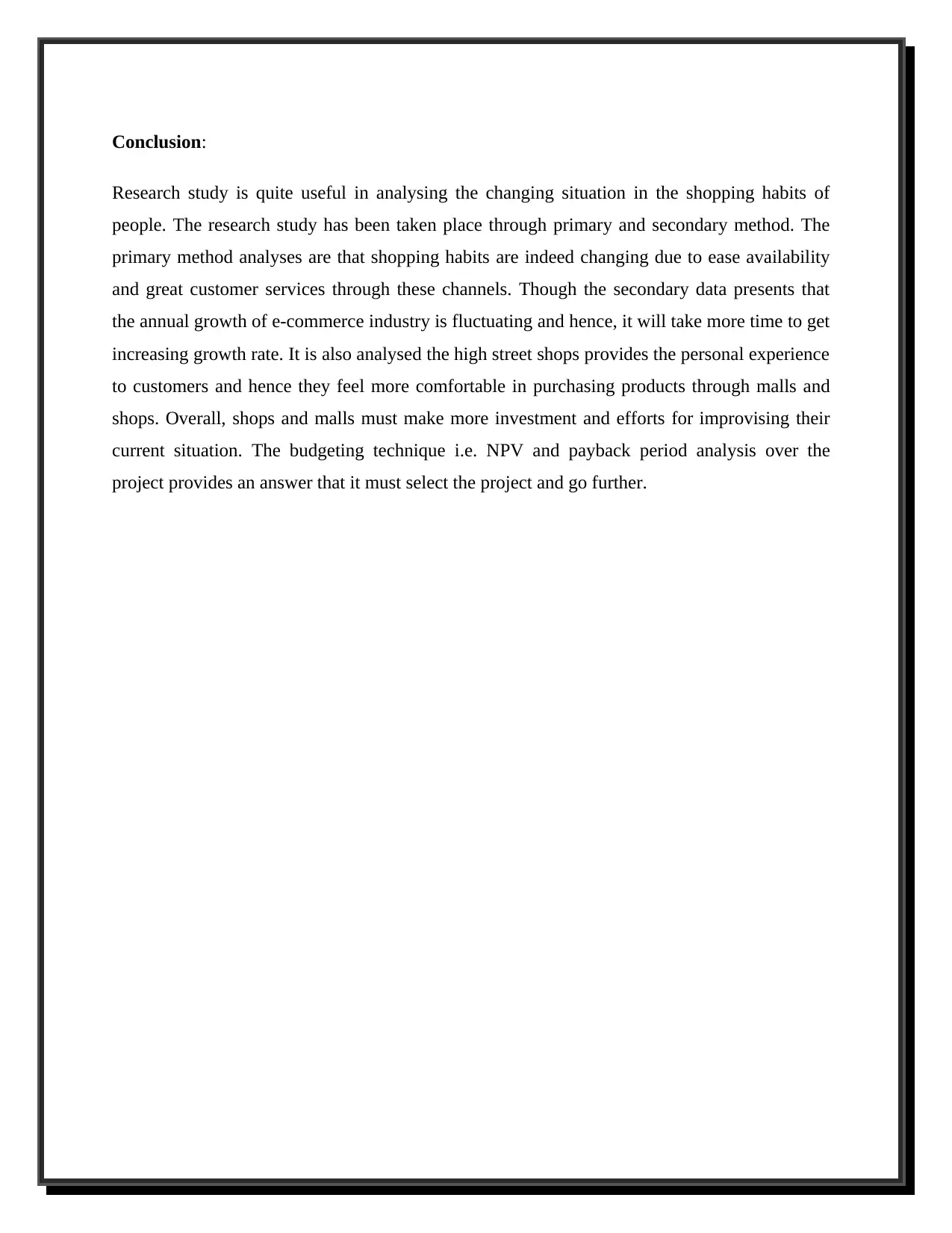
Conclusion:
Research study is quite useful in analysing the changing situation in the shopping habits of
people. The research study has been taken place through primary and secondary method. The
primary method analyses are that shopping habits are indeed changing due to ease availability
and great customer services through these channels. Though the secondary data presents that
the annual growth of e-commerce industry is fluctuating and hence, it will take more time to get
increasing growth rate. It is also analysed the high street shops provides the personal experience
to customers and hence they feel more comfortable in purchasing products through malls and
shops. Overall, shops and malls must make more investment and efforts for improvising their
current situation. The budgeting technique i.e. NPV and payback period analysis over the
project provides an answer that it must select the project and go further.
Research study is quite useful in analysing the changing situation in the shopping habits of
people. The research study has been taken place through primary and secondary method. The
primary method analyses are that shopping habits are indeed changing due to ease availability
and great customer services through these channels. Though the secondary data presents that
the annual growth of e-commerce industry is fluctuating and hence, it will take more time to get
increasing growth rate. It is also analysed the high street shops provides the personal experience
to customers and hence they feel more comfortable in purchasing products through malls and
shops. Overall, shops and malls must make more investment and efforts for improvising their
current situation. The budgeting technique i.e. NPV and payback period analysis over the
project provides an answer that it must select the project and go further.
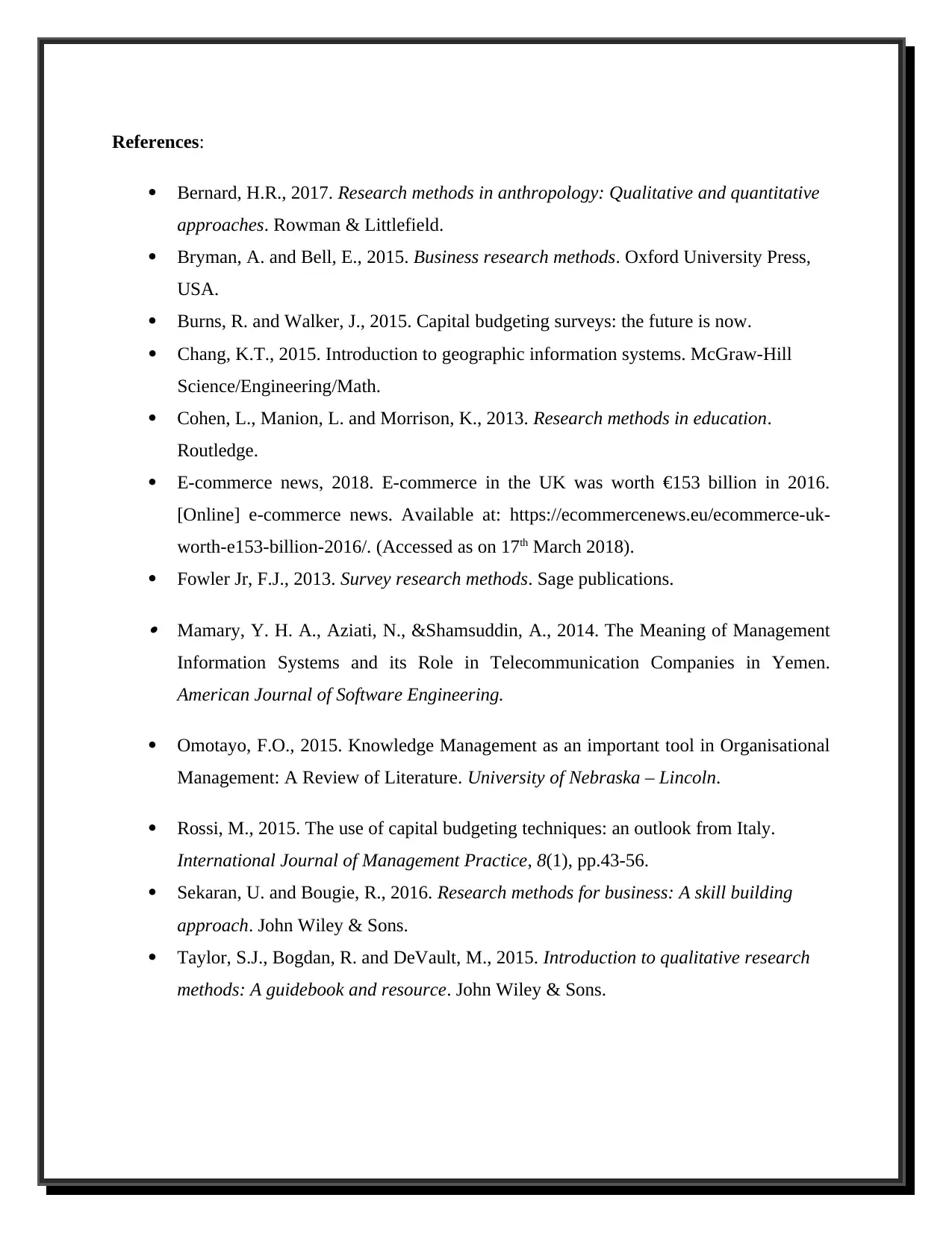
References:
Bernard, H.R., 2017. Research methods in anthropology: Qualitative and quantitative
approaches. Rowman & Littlefield.
Bryman, A. and Bell, E., 2015. Business research methods. Oxford University Press,
USA.
Burns, R. and Walker, J., 2015. Capital budgeting surveys: the future is now.
Chang, K.T., 2015. Introduction to geographic information systems. McGraw-Hill
Science/Engineering/Math.
Cohen, L., Manion, L. and Morrison, K., 2013. Research methods in education.
Routledge.
E-commerce news, 2018. E-commerce in the UK was worth €153 billion in 2016.
[Online] e-commerce news. Available at: https://ecommercenews.eu/ecommerce-uk-
worth-e153-billion-2016/. (Accessed as on 17th March 2018).
Fowler Jr, F.J., 2013. Survey research methods. Sage publications.
Mamary, Y. H. A., Aziati, N., &Shamsuddin, A., 2014. The Meaning of Management
Information Systems and its Role in Telecommunication Companies in Yemen.
American Journal of Software Engineering.
Omotayo, F.O., 2015. Knowledge Management as an important tool in Organisational
Management: A Review of Literature. University of Nebraska – Lincoln.
Rossi, M., 2015. The use of capital budgeting techniques: an outlook from Italy.
International Journal of Management Practice, 8(1), pp.43-56.
Sekaran, U. and Bougie, R., 2016. Research methods for business: A skill building
approach. John Wiley & Sons.
Taylor, S.J., Bogdan, R. and DeVault, M., 2015. Introduction to qualitative research
methods: A guidebook and resource. John Wiley & Sons.
Bernard, H.R., 2017. Research methods in anthropology: Qualitative and quantitative
approaches. Rowman & Littlefield.
Bryman, A. and Bell, E., 2015. Business research methods. Oxford University Press,
USA.
Burns, R. and Walker, J., 2015. Capital budgeting surveys: the future is now.
Chang, K.T., 2015. Introduction to geographic information systems. McGraw-Hill
Science/Engineering/Math.
Cohen, L., Manion, L. and Morrison, K., 2013. Research methods in education.
Routledge.
E-commerce news, 2018. E-commerce in the UK was worth €153 billion in 2016.
[Online] e-commerce news. Available at: https://ecommercenews.eu/ecommerce-uk-
worth-e153-billion-2016/. (Accessed as on 17th March 2018).
Fowler Jr, F.J., 2013. Survey research methods. Sage publications.
Mamary, Y. H. A., Aziati, N., &Shamsuddin, A., 2014. The Meaning of Management
Information Systems and its Role in Telecommunication Companies in Yemen.
American Journal of Software Engineering.
Omotayo, F.O., 2015. Knowledge Management as an important tool in Organisational
Management: A Review of Literature. University of Nebraska – Lincoln.
Rossi, M., 2015. The use of capital budgeting techniques: an outlook from Italy.
International Journal of Management Practice, 8(1), pp.43-56.
Sekaran, U. and Bougie, R., 2016. Research methods for business: A skill building
approach. John Wiley & Sons.
Taylor, S.J., Bogdan, R. and DeVault, M., 2015. Introduction to qualitative research
methods: A guidebook and resource. John Wiley & Sons.
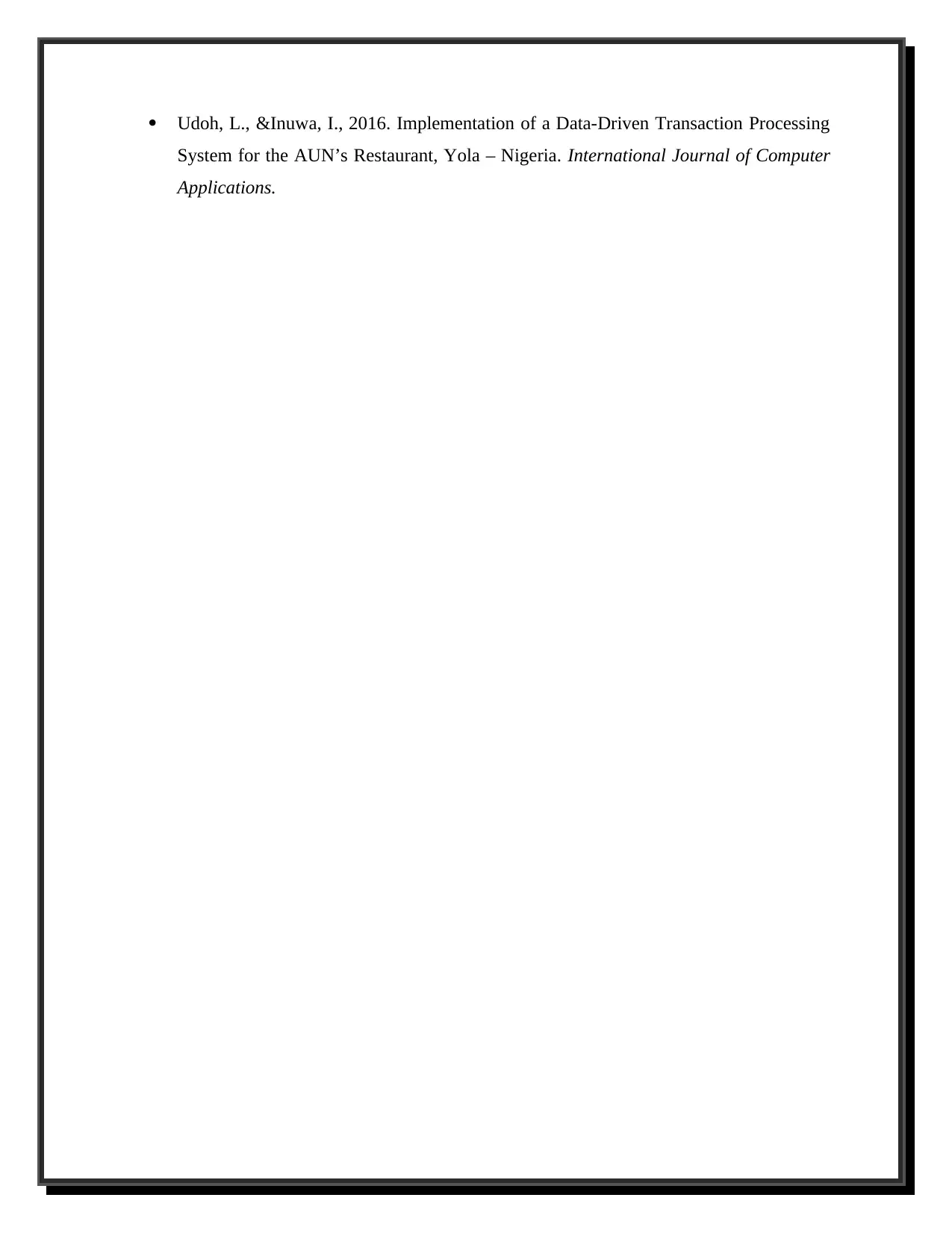
Udoh, L., &Inuwa, I., 2016. Implementation of a Data-Driven Transaction Processing
System for the AUN’s Restaurant, Yola – Nigeria. International Journal of Computer
Applications.
System for the AUN’s Restaurant, Yola – Nigeria. International Journal of Computer
Applications.
1 out of 25
Related Documents
Your All-in-One AI-Powered Toolkit for Academic Success.
+13062052269
info@desklib.com
Available 24*7 on WhatsApp / Email
![[object Object]](/_next/static/media/star-bottom.7253800d.svg)
Unlock your academic potential
© 2024 | Zucol Services PVT LTD | All rights reserved.





